How Images Unsettle: Learning from Photographic Diasporas
“Give us back our missing and murdered; our bruised, destroyed, humiliated and disappointed; those of ours who were and are lost strangers in their own land. Give us back our walking and eating and hunting and dreaming in this land and on the seas that claim us. We reclaim them from you and your history and photography and examples and professional codes and your capital that eats people and kills land and drains the water from it. And yes, from your sympathy too.”—William Ramp
Small Things Recollected
By Dr. William Ramp
“Ideas are to objects as constellations are to stars.”—Walter Benjamin, translated from Trauerspiel, 1928.
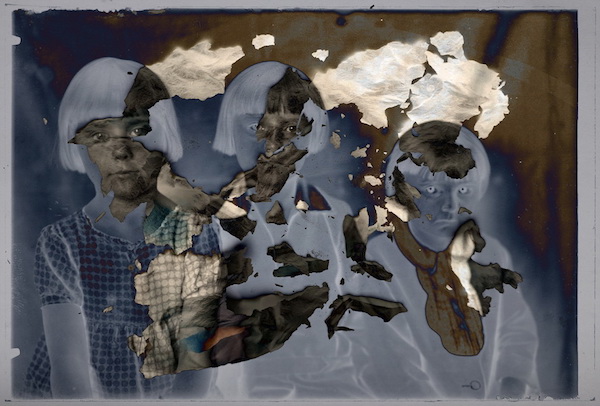
LETHBRIDGE, ALBERTA Canada—(Weekly Hubris)—March 2019—Welcome to Shoebox Archaeology, Round Two.
My last column took up a box of old, poorly-documented photos and ephemera to analyze as cultural artifacts with possible tales to tell “about technologies, techniques, and materials; about possessions, relationships, families, ways of life, fashions; about change and revolution.” I hinted that they might also tell us something about ourselves if we attend to how our interpretations negotiate “family membership, academic training, cultural habituation, and personal impression.” In that spirit, I asked how you might respond to them differently; what you might find surprising or disconcerting in them. “Does this approach sound trivial or idiosyncratic?” I asked. “Well, the definition of trivia is always relative and provisional, and attending to the idiosyncratic can reveal the politics of relevance.”
This month and next, I’ll put a little more emphasis on oddness and surprise. Teasing historical significance from insignificant objects—what a blue glass bead retrieved from a mound of excavated dirt might say about manufacturing techniques, trade routes, self-decoration, even politics—is intoxicating, but potentially exploitative in a just-so sense.
You approach a site—a dirt pile or a closet shoe box—with extractive tools ready: some mix of training in cultural or social history, curatorship or object-identification, a certain level of archaeological or archival savvy, some contextual information. You may already know what you’re looking for; easy then to squeeze your finds till they squeak out the story you want.
Yes, an ethic still applies: be as true as possible to the object—what can be said fairly in light of current knowledge about type, usage and context; how to respect lines between interpretation, speculation and fabrication; when to admit anomalies that don’t fit the narrative or gaps that open on to other explanations. But our purposes are always particular and so are we. Both are formed by background, context and motivation; by assumptions and habits of mind; by language, culture and social position; in short, by our location as inquirers within a given cultural matrix and web of social relations. These govern the practical production of what counts as legitimate scholarship, authorship, and truth in particular times and places.
We could be said to be cultural artifacts, too.
That doesn’t make us zombies, sentenced by cultural determinism to reproduce the same forever. If our sense-making is situated and limited, it is also dynamic, mutual, contradictory, slippery. We try to fix meaning—and end up changing it. But perhaps that sounds more like chance than freedom, a leap from the frying-pan of absolutism into the fire of relativism. (Perhaps you are already muttering “postmodernism.”)
I won’t resolve that philosophical conundrum here. I will suggest ways to cultivate openness to difference, relativity, and change while maintaining a practical commitment to truth, not as a possession or goal but as a methodical “rule” governing inquiry (in a Benedictine, vocational sense).
These amount to a via negativa: like Max Weber (and St. Paul, who “saw through a glass darkly”), I think Truth, like God, necessarily escapes our Faustian grasp. We approach it, if at all, through hindsight, mutual rebuke, and the resistance offered by reality to reduction at our hands. There is virtue in discomfiture; in attending to the disconcerting or unsettling; learning not to ignore the seemingly insignificant or the suppressed; reading against or across accepted narratives. Yes, do still fan sparks of inspiration into new narratives, but provisionally.
A while back, I employed someone to help me de-clutter a no-longer navigable office. Employment morphed into something more like an intense archival partnership as we waded through two metric tons of paper, both despite and because of our very different investments. My keep/discard criteria and my sense of extended material selfhood were challenged, and they changed. I came to trust a process different from the one intended. I still kept track of what went into the bin (and of course, got caught out retrieving things). I also photographed discards. Two juxtaposed file folders in one of these images eerily evoked the larger redirection.
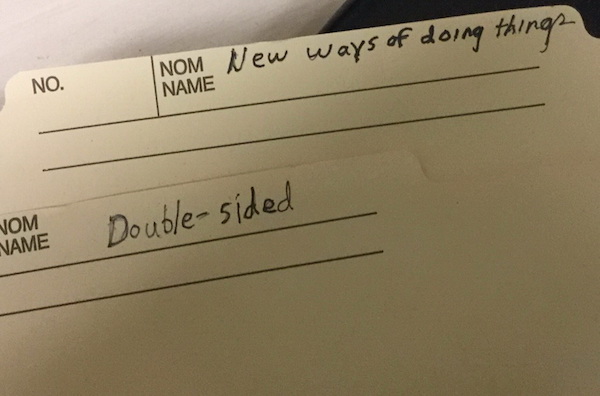
At many universities today, a non-academic department has gained power and centrality: at mine, it’s called the Advancement Office. Advancement deals with publicity and funding initiatives. It encourages aspects of our work that can be developed into feel-good success stories, using words like excellence, innovation, entrepreneurship, vision, and discovery to spin webs of good will captivating to donors, corporate partners, and parents of prospective students.
This work is part of a symbolic economy; a régime of promotional ranking and accountability, encouraged by administrative and governing bodies focused on commissioning, producing, distributing and receiving reports. It inflects the priorities of research and scholarship. Ironically, the tangled restrictions, standards and informational exactions that now burden funding and employment applications complement an emphasis on sales messaging. Both tend to discourage scholarship with a potential to discomfit, or learning from failure, in favor of compliance with Strategic Priorities and Objectives, and the interests of “stakeholders.”
That might work for re-engineering within accepted parameters, but not for critical understanding. It makes of “innovation” more of the same, with enhanced efficiency and appearance, and treats difficulty, resistance, or friction as enemies of transparency, resisting the insight they might convey. It requires papers in order at the border, a detailed itinerary, advance accounting for all costs. Of course, I exaggerate: there are niches and there is practical leniency. But the process creates a penumbra of expectations ill-suited to free inquiry and the public interest.
The issues we face demand better: a creative, holistic attention to the recalcitrant exhaustion of complex and complexly-stressed environmental systems (called, with astounding technocratic hubris, “ecosystem services”), communicated urgently by unpredictable weather, melting ice, bleached coral, depleted soil, dry aquifers. A similar exhaustion in human systems shows in pervasive anxiety, depression, passivity, and distraction; in the depletion of common and personal resources for human sociability; in viral paranoias and panics that stampede the gullible toward exactly the worst answers to societal ills.
But these stressors also leave early, often unnoticed clues in small, uncanny events—an inexplicable die-off of a remote species; an unexpected spawning-run failure; new diseases or wildlife conflicts along bush borders, a growing trickle of displaced people, a flicker of everyday “ugly feelings;” paranoias that begin to colonize or divide civic space. These are often ignored by established organizations or disparaged by rear-view-mirror pundits. Ironically, they are also missed by those who pounce with gotcha-surety on the merely coincidental as Signs of a Great Secret. (There is a legitimate mode of inquiry called abduction; conspiracy theorists are abducted by their misuse of it, and I have no magic antidote.)
A delve through a few prosaic or even interesting images from a box of old ephemera isn’t going to save the world. But the same general ideas about inquiry hold here, too. Old photos, as documents of personal life, inadvertently document personal troubles, and personal troubles, cumulatively and connectively, make public issues. So here are a few tips on how to take care to notice what is communicated in odd and inconsequential shifts, slippages, or resistance, whether in the form of climatic or social anomalies, or human detritus and cultural discards. Photos taken on box Brownies or smartphones, whether on the spur of the moment or as conventional memorials, whether tipped haphazardly into boxes or saved on random flash drives, even without inscriptions or metadata, can be material occasions for insight, ideas, stories, pauses, redirection. Here’s how.
First, a Zen lesson: don’t get trapped in willed attention. To will is to focus; to focus is to frame; to frame is to exclude things from the frame.
Second: subvert order. An exercise I sometimes use with students is to have them select two disparate documents more or less at random and construct a third by interweaving alternate sentences or parts of sentences from each. The resultant splices often produce startling synchronicities along with the expected gibberish. Look for odd juxtapositions or make your own, and see what results.
Third: attend to the weird and eerie. Ralph Eugene Meatyard took scores of images that look like weird and badly-composed family photos but were in fact meticulous visual compositions with a strong mystical bent. They disturb photographic and social conventions to open other dimensions of perception, relationality, even spirituality—not without difficulty and resistance on the part of some viewers. Likewise, Orthodox Christian icons, which may appear primitive and strange to the post-Renaissance eye, operate in terms of a different model of perception: the icon sees in to you. Realism, said Mark Fisher, is not the Real but the flat obviousness of “no alternative”; for intimations of the Real, attend to its apparition as the weird before you and within you. Heed the intrusions of ostensibly-vanished (banished) histories, material ghosts, palimpsests that disturb the here-and-now that is the conceit both of normal life and of the everyday photograph.
This kind of attention works particularly well as an element of creative and material practices such as collage or bricolage. The Surrealist movement used collage to unsettle and disarrange perceptual conventions and categorical distinctions with the aim of making possible new modes of social and psychological inquiry into the configuration of dreams and daily life. Like the technique of free association in psychoanalysis, Surrealism proposed that significance hides in view; the important laughingly pretends to be inauspicious; the actual takes disguise as the fantastic.

Fourth: take disorder seriously. Treat disturbed ground, compromised ecosystems, political and social derangements, trash, as worthy of study, not obstacles to inquiry. Yes, of course disorder robs artifacts of information. Significance dies by backhoe, bulldozer, and bombs; in flood and fire; under the careless assault of knives, paints, solvents, glues; even from well-meaning attempts to conserve and organize. Nevertheless, disorder is a process from which regularity and pattern are not absent. Mess is an artefact of human life, which produces disorder in the very attempt to realize or purify the should-be. Rather than lamenting its failure, attend to what it indicts.
Fifth: unsettle yourself. In 2012, a fresco (below) depicting Jesus in a Spanish church was “restored” by a well-meaning but untrained parishioner. The result went viral on social media. Take the two images below as a litmus test, but focus on how you feel as you view them. What judgement issues from that feeling?
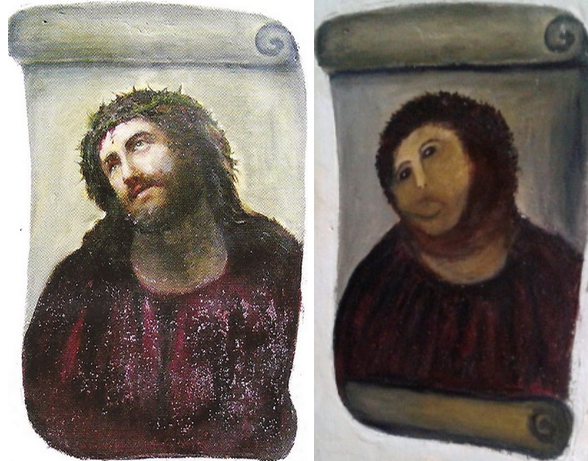
Did you mentally double the loss of the original in disgust at the repainting? Does your reaction align you with certain established priorities (art critics, preservationists, cultural tourists, news editors) and not others?
Now, look at this image. The original’s in the Met; it’s a medieval depiction (Nottingham School) of the head of John the Baptist. (See what I did there by inserting the words “Nottingham School?”) Again, check your first reaction, which will be affected by the two images you’ve just seen above. No, I’m not judging this image as equivalently bad. I’m only asking, do you register any similarity before you began to rationalize what you see and discount what you first felt? What might your first reaction and subsequent rationalizations indicate about the latent architecture of your judgement and its no-go corridors? Notice your first feelings.
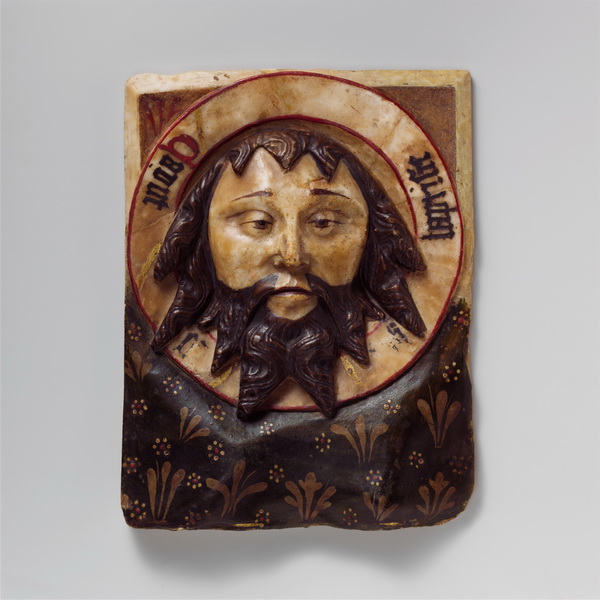
Juxtaposition, bricolage, and other modes of disorientation crack open a different illumination of subject-matters and subjectivities; of all the patched survivals of our Humpty-like fall into corporeal and cultural life. I bring to bear several disparate roles and subject-positions on the images below: sociologist, historian, family member, aesthete, white male of a certain age, member of the middle class. Each of these can contest others: family loyalty or moral judgement vs. sociological or historical training; aesthetics vs. cultural analysis. Each may also be internally-conflicted. I flag a few of these collisions; think about yours. Can fleeting discomfort signal the persistence of some dislocated and dislocating history?
Sixth: embrace diaspora. Dislocation can be salutary; social margins often provide fertile soil for insight. Diasporic peoples, under constant pressure and episodic persecution, have enriched unwilling and even unwitting hosts. Think of what Jewish and Armenian diasporas have contributed to philosophy, literature, science, and the arts. Or the Romani to decorative art, oral narrative, and the cross-fertilization of musical idioms from Rajasthan to Finisterre to America. Spare a thought, too, for culture-bearers of the newest diasporas that manipulators of the ignorant and fearful slag as “migrants.”
Portable artifacts likewise accumulate new meaning in new hands even as they shed signs of their origins. We are awash in a flood of dislocated images that no Trumpian wall can stem. In the 1920s, Walter Benjamin, a quintessential diasporic thinker, argued that the accumulated detritus of amateur photography formed an inadvertent archive of the social unconscious, documenting the latent production of social life, all the better for doing so haphazardly. Perfectly visible through the lens and on the print, this latent world-making goes unnoticed in a marriage of selective attention to routine oblivion at work in editing, sorting, discarding. This is how police, journalists, academics miss things; how political and military intelligence fails. This is how carefully-curated, de-cluttered, joy-sparked interior decoration produces interesting visual artifacts of denial. A full understanding of consumption must respect the multidimensional, contradictory, and dynamic relations of humans to things and things to other things; must respect the persistent irreducibility of the material we pass on to others, drag from place to place, arrange or store; the manifold ways that possessions possess.

Seventh: be discerning about betrayal. To emphasize chance and disarray in the study of image collections or other sites might seem to risk a betrayal of context, particularities of subject-matter or identity, photographic intent. To be clear, it does. Even Foucault, advocate of counter-memory, pursued it through “grey, meticulous and patiently documentary” work of archival excavation and evidentiary connection “on a field of entangled and confused parchments, on documents that have been scratched over and recopied many times.” Doing justice to the counter-intuitive apposition of statements, images, texts or artifacts entails taking careful measure of distinctions, differences, and distances. Still, the most careful mapping of in situ articulation can’t eliminate infidelity. Johan Huizinga’s evocative description of late-medieval Flanders arose from a youthful wish for total immersion in the presence of the past; its sights, sounds, smells, feelings. But his intellectual and political baptism made him the 20th century’s own and his work embodied that citizenship. Clio’s most loving child resisted a full embrace.
I wrote once in a Weekly Hubris column of how my father’s outlook on political morality was shaped by his experience of Nazi occupation. He read it and was pleased. But it differed from his own memoir. And arguably, even his account, written in late maturity with benefit of hindsight and much subsequent reading, betrayed the boy who was father to the man. Neither account is false, but both differ from the original experience; both shed light and cast shadow on it. A certain betrayal is integral to differentiation from past and parentage; to becoming ourselves. It’s not to be laughed off. Loyalty is born of and responds to leave-taking, and it multiplies Clio’s voice.
Eighth: embrace translation. Every act of identification, counterintuitive or not, snags something for interpretation. Interpretation is unavoidable, and its attempts to keep faith with what it interprets inevitably produce something new. It admits to but assaults difference. As in translation, interpretive purpose is conditioned by the very difference it wishes to bridge, in context, readership, horizons of expectation. Traduttore, traditore (translator, traitor) runs the Italian proverb. Translation offers and obscures its subject in the same gesture: its history, says Flora Ross Amos, is of ambiguity:
The very term “translation” is long in defining itself; more difficult terms, like “faithfulness” and “accuracy,” have widely different meanings with different writers. . . . To one writer fidelity may imply a reproduction of his original as nearly as possible word for word and line for line; to another it may mean an attempt to carry over into English the spirit of the original, at the sacrifice, where necessary, not only of the exact words but of the exact substance of his source.
Amos concludes that the translator should “look upon translation as a promising experiment, rather than a doubtful compromise.” I would say it’s both.
Now to this month’s image mix, old and new: phone pics, snapshots, studio photos, a news clipping. Some of my observations on them illustrate the approach advocated above; others stray a little from it. Some are lighthearted, others serious, even didactic. Some speculate, others revert to standard modes of interpretation. Overall, they are more impressionistic than academic, more suggestive than exhaustive. A selection of next month’s images will arrive with cryptic annotations or none. Though chosen for reasons, they will be left open to your response, in much the same spirit as the image-only sections of John Berger’s classic Ways of Seeing.
![]()
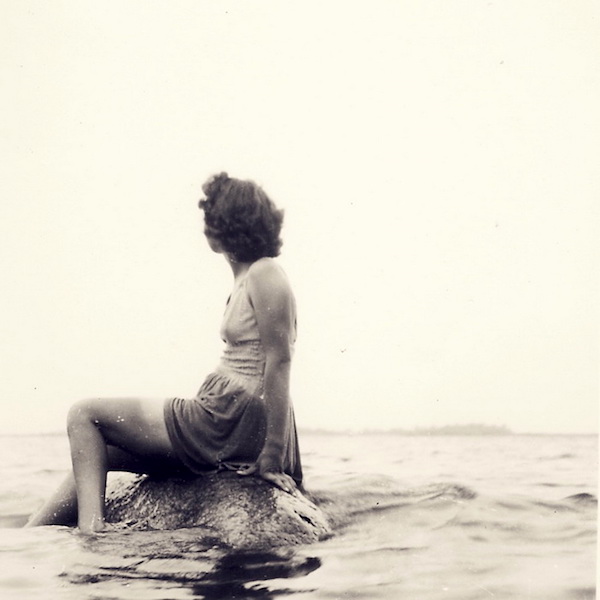
There is no inscription on the back, and her face is turned away. I don’t know for certain who she is, where this photo was taken, nor when. Likely the late 1940s or early 50s, somewhere in Canada.
It doesn’t matter. The pose is near-perfect, as is the composition, which I’ve assisted with a tiny, judicious crop. Did taker or sitter have in mind that famous statue in Copenhagen Harbor? Who knows? If they did, it’s a worthy tribute. But what is it about women sitting on rocks, legs (or Mermaid’s tail) folded under, gazing pensively out over water, that makes of this a quintessential gendered genre pose? What does it evoke? What would it evoke if you substituted a man for the woman, or the woman in a business suit, or a dog? A meadow or a prairie landscape for the water? Or a city street? Imagine the sitter, posed and dressed as she is, in the middle of a Manhattan or Tokyo intersection. How would that violate which meanings . . . or suggest others? What evocative relations between personhood and objecthood, between the human figure and water, rocks, horizon, are suggested here?
Why ask these questions? Go look at the Wikipedia page for the Little Mermaid of Copenhagen. Read about how she has been decapitated twice (once by Situationists); has been blown up; has had a limb sawn off; has been drenched in paint, has worn a burqa. She was modeled on a ballerina who caught the eye of a beer baron’s son. What about her attracts these other, wildly diverse responses? How has she become a magnet for such a cacophony of violence?
![]()
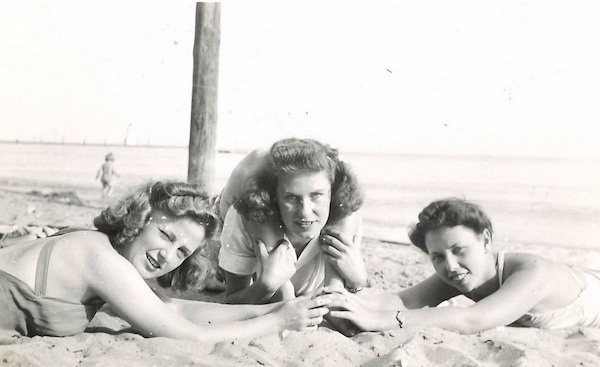
A summer’s day on a Great Lakes beach, mid to late 1940s or early 50s; an image of similar vintage to the one previous. The print has a number of spots that could be water droplets or grit on the lens, or artifacts from processing the negative. Again, there’s nothing identifying written on the back. I didn’t recognize these women; nor did a cousin who was custodian of the shoe box it was in. But my mother thought she did, just barely. When I showed her the photo, she averred that they might have been Farmerettes. These were young women recruited through a national program during both World Wars to replace male labor on farms. The program continued to operate in Canada into the 1950s. Clearly, there was time for fun, too.
But there’s an oddness about the image worth noting. The utility pole jarringly bisects the scene, but probably was invisible to whoever took the photo. The woman in the center is wearing a blouse, not a bathing suit. The painstakingly-bouffant hair on those heads has not been wet, nor disturbed by rubber caps. And look closely again at the central figure: she’s holding someone’s shins, and the other two are using their hands to cover the feet those shins are attached to. The droll facial expressions indicate that this oddity is to be noticed. Whose shins? What gives?
They are looking at the photographer who is perhaps another member of the group; maybe daring her. (Hmm . . . . I assumed the photographer was female. I also assumed she might be a farmer-employer’s daughter. Why?) But a conceit of the camera is that they are also looking at us, far; that their eyes and ours still meet despite our distance in time and place. They could be any women at any time, aside from minor fashion cues that date them, and the fact that they would have been called “girls,” then. But if any of them are still alive, they would now be in their nineties.
There’s now a young-adult novel (Gisela Tobien Sherman, The Farmerettes, 2015) about Canadian Farmerettes. It’s a tale of friendship, tension, and budding sexuality; of relations between young urban women and a farmer’s daughter of about the same age. It shows evidence of careful historical research but also of a tinge of presentism, representing its characters as like young people today in their struggle to fashion selfhood, agency, sexuality. It’s an attractive way to present history.
But to what extent did they really think and feel just like young adults today? Would they have been just like us had the lid of mid 20th-century convention been looser? Or would they have read the book and found it strange, even if they did, in their time, struggle to define the same dimensions of selfhood we struggle with today? There are other questions that could be asked about the Farmerettes program. Did its national planners and field agents, the farmers and Farmerettes see the program in the same light and use it for complementary purposes? Was it about more than the provision of farm labor in tight times? Did it have a civic-socialization element like that of 4-H?
Which brings me, finally, to plug a book about 4-H that unsettles the history of that beloved rural youth organization, making it seem, at times, quite surreal. In The 4-H Harvest: Sexuality and the State in Rural America, Gabriel Rosenberg presents a cast of sometimes very strange characters circulating through the national leadership of the American 4-H movement, and the similarly-disconcerting ideas they espoused about the breeding of heifers and of young farm women; how 4-H brushed up against eugenics in its early days and against US agricultural imperialism later. A shaker of high-octane biopolitics to cut the sometimes cloying bouquet of rural nostalgia.
![]()
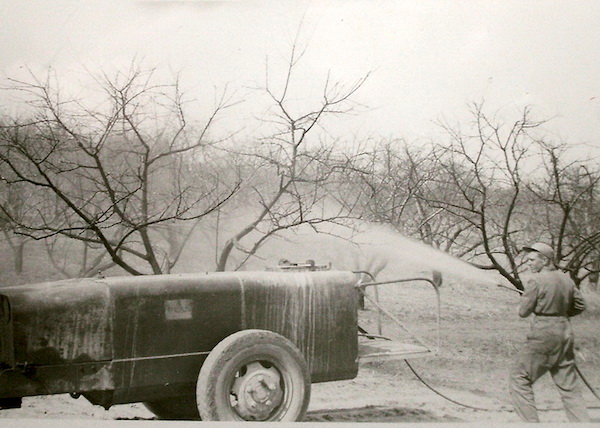
Viewed prosaically, this early 1950s image is little more than slightly interesting. That’s my dad spraying a peach orchard owned by my maternal grandfather. I hadn’t seen it before this past summer, though I witnessed the real event many times. Somehow, the image chilled me. It might have been his unintentionally martial stance with the spray gun; the aimed reach of the lethal and visible fog; the lumbering bulk of the sprayer; the stark, leafless trees, the gunmetal sky. And that he was not wearing a respirator!
When I considered my reaction, a 1920s imagist prose poem by Raymond Knister came to mind. It detailed this very activity, but re-set it in another context:
“. . . Beside him is a yellow trumpet of fog from the gun, two
hundred pounds pressure of poison loosened on the
pink well-rooted young trees.
He thinks of a yellow-green poison cloud four years, four
thousand miles away, the sight through gas masks,
through slit of swivelled gun, in the roar and the
rhythm unabolished by lurchings, as the tank gropes
forward . . .”
Is there some surreal resonance between food production and war? There are certainly connections. Herbicidal sprays have been used in both agriculture and war since the 1940s, and sometimes their chemical compositions differ little. Combatants, civilians in the path of the spray, and farmers, have suffered short and long-term consequences of such chemicals. My dad may have been one.
Napalm was sprayed from visually-similar hoses.
And before the Second World War, Germany built a chemical industry second to none in the face of mounting restrictions on access to depleted supplies of guano (nutrient-rich deposits of seabird droppings mined in seams a hundred feet thick in the competitively-colonized South Pacific islands). The chemical composition of some common fertilizers, and their mode of manufacture, were not that far removed from the explosives used to propel shells and fill bombs. That’s why my mom remembers that, during the Second World War, military guards were posted at the entrance of every major fertilizer depot to inspect farmers’ papers, and their trucks.
![]()
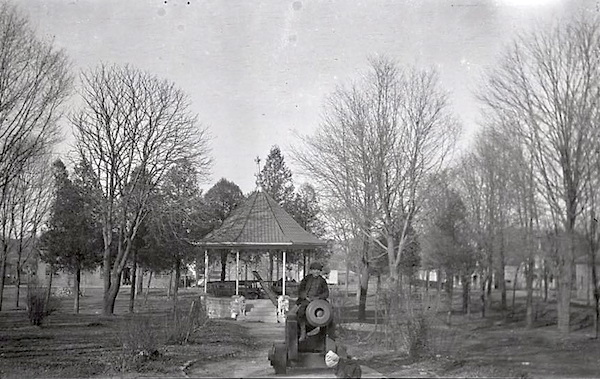
It seems there was a time when nearly every small, somnolent eastern or mid-western North American town had a central square, a bandstand, a cannon, a perchable kid, and a snapshot-artist thinking, “Now, there’s an image!” while carefully setting down her luggage . . . not quite enough to the side to be fully out-of-frame. And thus we have—you knew it was coming, didn’t you—the cannon shot.
This particular weapon was given up by an eager town council during the Second World War to be melted down for the cause. For a few postwar decades, it was replaced by a modern field artillery piece. That in turn went to another destination and has now been supplanted by a naval carronade (a light, short-range cannon) of roughly equal vintage to the original occupant.
Nothing at all unusual about cannons in town squares. But let’s make it odd for a moment. Why were they once so common in that particular spot? Town councils did not raise or command military units. These somnolent iron beasts could not defend a county courthouse or town hall; they were as often as not pointed at them. One obvious response is that they constitute a kind of anonymous memorial to Our Glorious Dead, a supplement to the equally-ubiquitous cenotaph.
But let’s broaden the perspective a bit. If parks of a certain age don’t sport guns, they often do feature crouching stone lions, just as do bridge abutments, gateposts, and plinths. This phenomenon crosses cultural divides: think, for example, of Chinese temple lions. So, these signifiers of ferocity are symbolic guardians of sorts, but of what? Perhaps they a mark a threshold or boundary in the layout of civic space; a place where one is supposed to feel a little different; a liminal point. Entrances, exits, boundaries have long been surrounded by myth and ritual. The Roman god Terminus lent his name to boundary markers at which sacrifices were made by landholding families during a ritual festival called Terminalia.
Guns and lions similarly mark corridors or spaces to cross carefully. The bridge might collapse, after all. Walls and gates may be breached. Town squares punctuate populated spaces, stand still in the center of street grids and interrupt their commerce. But things can happen in them: festivals, markets, bandstand concerts. Or political gatherings, riots, lynchings. Perhaps, despite their official status, there is something about them that Foucault termed heterotopic; a quality of “other spaces” that guns and lions symbolically direct, accentuate, or quell?
![]()
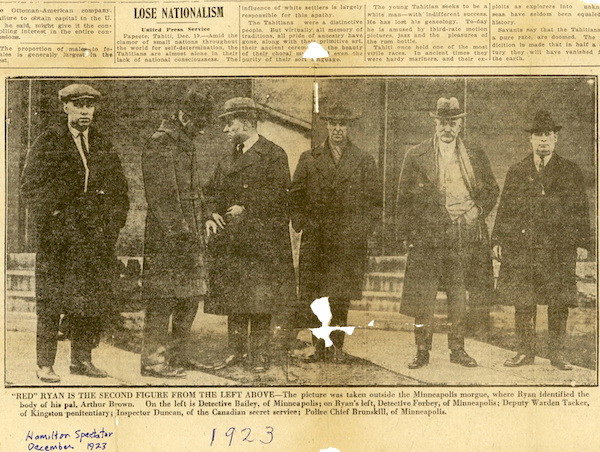
A saved news photo added to a box of old snapshots records the capture of a storied Canadian bandit in Minneapolis, late 1923. It’s interesting that whoever clipped it left an inch of unrelated material above the photo. So, let’s relate it. Note the filler piece in that strip, titled, “Lose Nationalism.” It reports on a South-Pacific social failure which it openly admits was caused by the “influence of white settlers,” though this is filtered through moralized victim-blaming. “Amid the clamor of small nations for self-determination,” it proclaims, young Tahitian men had “lost [their] geneology” [sic] along with their virility, and were slouching toward racial doom without pride or purpose, “amused by third-rate motion pictures, jazz and the pleasures of the rum-bottle.” The references to virility, genealogy, and national self-determination make an interesting juxtaposition with the photo below them. We’ll come back to this.
Now, the photo: Second from the left is the crestfallen Red Ryan, already on his way to becoming one of the most famous men in Canada for his exploits on both sides of the law; flamboyant bank robber, colorful penitent, and astounding recidivist. He is here the very picture of despair. Does he feel it? Or does he know the cameras are on him, and that it’s time to project a new persona with all the emotive élan he can muster?
His escape several months earlier from the Kingston Penitentiary, the hardest jail in Canada, was chronicled and partly fictionalized by a young Toronto Star reporter named Ernest Hemingway. Twelve days on the lam, he held up the Bank of Nova Scotia branch at Oakwood and St. Clair Avenue in Toronto (where, 57 years later, I would do what banking I had as a penurious graduate student). Within a matter of weeks, he was robbing banks and living the high life in the US Midwest, until the capture pictured here. Returned to the penitentiary, he would become Canada’s most cloyingly exemplary prisoner and author a book titled with a singular lack of imagination, The Futility of Crime. In the fall of 1935, he would be released on a wave of prison-reform sentiment and popular appreciation for his obvious rehabilitation. And in May 1936, he would end yet another bank-robbing spree in a proverbial hail of bullets in Sarnia, Ontario, taking a police officer down with him.
And second from the right, coat open and mustachioed, is a very gratified Walter Duncan, Inspector, Dominion Police of Canada, Special Agent attached to the Department of Finance, dogged tracker of booze-caches, rum-runners, fraudsters, bent politicians, communists, and immigrant radicals. A self-legendary marksman, he was happy to have bagged a big one and to be in the news and in the running for a widely-publicized reward.
A Scots farmer’s son who came to Canada in the 1880s, Walter Duncan spent his first months on new soil planting the apple orchard that surrounded my childhood home. But he also represents a family tradition. A brace of his first cousins, siblings, and nephews would, like him, make their mark in policing, the military, or both. A certain martial pride hung about his kin like the smell of mothballs on tartan. From it, I inherited a love of pipe music and a cradle affinity for traditional hierarchy and pomp that proved hard to shake, even when later acquaintance with working-class history made it clear how often such affinities went with an enthusiasm for breaking heads and strikes.
Walter was proud of his ethnic heritage and of the way uniformed Scots dominated the command structure and disposition of Empire. He got in the papers for declaring war on “loafers” in 1905; reorganized the Toronto detective branch; ran his own private agency for a while; corralled draft-evaders during the Great War. He enforced Prohibition north of the border and did his best to keep America dry south of it by busting smuggling gangs. (There’s no evidence that this work influenced his own attitudes toward drink, when it was legal.) On American soil and relaxed in this photo, his feet are still planted firmly on the rock of Order.
However, the flip side of his character was that he worked best not in a rigid hierarchy but as a freelancer, undertaking “special” tasks and reporting directly to the top.
Walter’s only son, Cameron, served in the naval volunteer reserve during the First World War as a radio telegraph operator on HMCS Acadia, gaining the rank of Warrant Officer. Acadia, a former survey vessel, was assigned to antisubmarine patrols of maritime approaches to Halifax, Nova Scotia. She was in Halifax harbor December 6, 1917 when the freighter Mont-Blanc, fully loaded with munitions, collided with another ship and caught fire. The resultant 2.9-kiloton blast was the largest non-nuclear, human-caused explosion in history, and leveled much of Halifax. If my grandfather had his story straight, Cameron (his second cousin) was one of the first to telegraph the disaster to the outside world.
Acadia lost much of her glass but was otherwise little damaged and had a long subsequent career. Now in her 107th year, intact and under restoration, she is the largest single artifact in the collection of the Maritime Museum of The Atlantic and the only survivor of the Halifax explosion still afloat. Until 2015, her crew included a rare holder of a distinguished naval commission: a four-footed Rodent Control Officer named Erik The Red. For his hair color rather than his politics.
Seven years after my grandfather left the University of Toronto’s School of Practical Studies with a BASc in electrical engineering, Cameron returned from the navy to the same program, specializing in radio. His 1922 graduation entry in Torontonensis, the school yearbook, notes that he was “not a fusser.” His father would have approved: a man of definite action, not a pedant. That same year, Cam received a government title that weirdly echoed his father’s: Radio Inspector for the province of Ontario. That bit of wireless fame went out—heh—on the wires and earned him the moniker “First Radio Cop” two thousand miles west in my own city’s paper. He went on to catch the boom years of radio engineering in the private sector, but it is said he returned to military work in radio research during the second war. He died suddenly in 1950, leaving a wife and two sons.
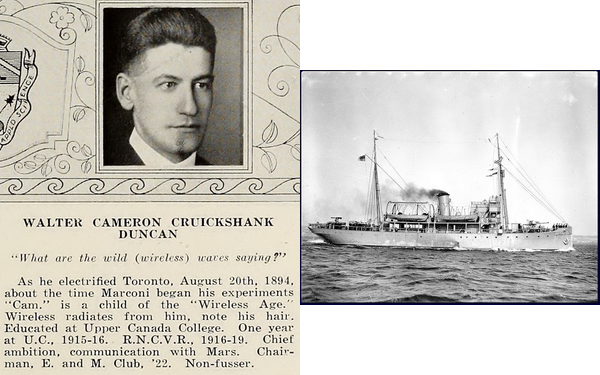
Cameron’s widow, Norma, soon moved to the United States, for reasons now unknown, and married a Hungarian émigré musician who styled himself Henry von Gerber. (His daughter, Francesca Marlene, who thereby became stepsister to the Duncan boys, was already on her way to Hollywood stardom under the name Mitzi Gaynor). Norma’s elder son, Donald Walter Duncan, also moved south, joined the US army, and was naturalized as an American citizen in 1955. To him I now turn, and on him this entire vignette, perhaps this whole column, turns.
Don Duncan’s choice of an army career appears unsurprising in light of the culture of his paternal family. He bore a certain square-jawed resemblance to his father but, by his own account, it was his stepfather’s influence that was decisive. Gerber was Roman Catholic and a devout anticommunist at a time when Catholicism, anticommunism, and the CIA had begun to form a holy trinity of American patriotism. Don adopted his anticommunism and was outraged when the Western powers stood by in 1956 as Soviet tanks rolled into his stepfather’s homeland. He began to admire those units of the American armed forces trained for special operations with a wide latitude and a mandate to get things done.
His first decade in the military seemed relatively uneventful: there was no meteoric rise, just a slow plod to Master Sergeant. But a closer look tells a different story. Don took and excelled at training opportunities and leadership roles, including those blandly covered by the phrase “operations and intelligence.” In 1961, he joined an object of admiration, the Special Forces, where he continued training in operational intelligence, communications, weapons, and demolitions. In March 1964, he took all that and his dedicated anticommunism to Vietnam. There, he was soon assigned to the setup of Project DELTA, a task group combining Special Forces and South Vietnamese army (ARVN) personnel to gather operational intelligence. In fact, as its Wikipedia page makes bluntly clear, it did much else besides.
DELTA’s mission included operational and strategic reconnaissance into long-held Viet Cong areas and the direction of air strikes on them. They were also to conduct bomb damage assessment, conduct small scale reconnaissance and hunter-killer operations, capture and interrogate VC/NVA, tap communications, bug compounds and offices, rescue downed aircrew and prisoners of war, emplace point minefields and other booby traps, conduct psychological operations, and perform counter intelligence operations.
Duncan’s value to the project emphasized evaluation and co-ordination—“office” jobs—but soon he was out with the hunter-killer teams on field operations and in combat. He also trained ARVN troops in the arts of counter-insurgency warfare.
It was the perfect set-up for a convinced enemy of communism and a highly-trained soldier with an independent streak, one attracted, like his grandfather, to special operations with a broad mandate that encouraged autonomy and required a diverse skill-set; operations with a sharp end in the field but close ties to the top. And Duncan rose quickly, proving to be a superlative intelligence operative who was also audacious and courageous under fire. He was commended. He was decorated liberally by his own military and by the ARVN. He briefed Secretary of Defense McNamara personally. He met General Westmoreland, the eminence grise of US involvement in the war. He was on the road to officer status and a brilliant military career.
But something about the war and his role in it profoundly changed Don. He refused a field promotion from Master Sergeant to Captain; refused another tour and returned home. He wandered around Berkeley, talking to people, one of whom took him to the offices of a Catholic anti-war magazine with a growing circulation, called Ramparts.
When the February 1966 issue of Ramparts hit the stands, it did so with a dramatic full-cover head-and-shoulders image of Master Sergeant Donald W. Duncan, immaculately kitted out in full dress uniform. There’s a typographically-unobtrusive runner at top, “‘The whole thing was a lie!’ by a Special Forces Hero,” and beneath the masthead, “I Quit!” in a larger but still modest point size. But it’s the photo that made the cover iconic; I’m sure thousands still remember it. Duncan glances sideways and guardedly at the viewer. He appears desperately haunted. Instead of being the object of America’s gaze, he seemed to reverse the relation, looking into a darkness of soul enveloping Americans.
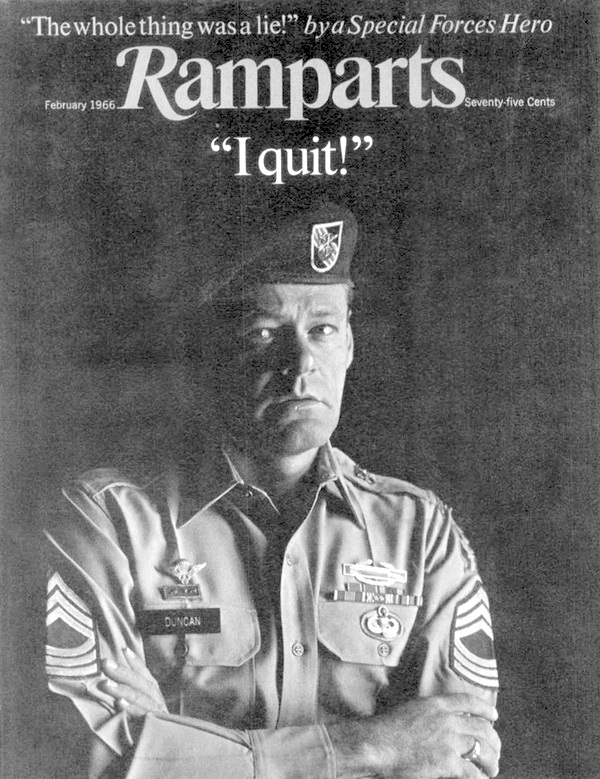
The relation between the photo and the two-word quote is interesting. Duncan quits, but he quits in uniform. (His FBI file contains some discussion of whether his wearing of that uniform in the circumstances constituted a chargeable offense.) Uniforms are symbolic. More to the point, they are sacred. Sacred items are set apart from ordinary ones by rules and interdicts; uniforms are not to be treated like civilian clothing, and they set apart military bodies from civilian ones. They are worn, and eventually may be worn out, but wearing a uniform and insignia rightly is defined by protocols and prohibitions that distinguish them and their wearer from the merely civilian.
Like a business suit, a dress uniform is intended to add stature to the human figure; to square and straighten it up for display. Since the end of the 18th century, its utility has been mainly symbolic. Like all modern soldiers, Don would have spent most of his active-duty time in fatigues. Nor does parade-ground stature matter in battle. Soldiers creep, freeze, run in a crouch, keep low, hide.
In the Ramparts cover image, the uniform does symbolic work, aided by very skillful lighting. It contrasts with (and thereby highlights) the half-shadowed face of a man who has seen terrible things but knows how deep his own implication runs. It asserts that Master Sergeant Duncan comes from the other side and brings truth with him; reminds readers that he fulfilled a duty; that his experience is real. He is set apart from other war resisters by having been there. But while the image is stark, the meaning of the uniform is ambiguous. The sociologists Emile Durkheim and Robert Hertz, both familiar with military symbolism, noted that sacred things can switch polarities and remain sacred. Something venerated by a group could suddenly become repulsive; in both instances, it would remain set apart by prohibitions. For a Ramparts reader, the image works here because the uniform connotes an implicit double meaning.
Compare the Ramparts image to that of Don’s grandfather in 1923. Special Agent Walter Duncan needs no uniform and is studiedly casual, overcoat unbuttoned. He does stand squarely, “at ease,” but his status and legitimacy are vouched for by the puffed chests of his colleagues and, conversely, by the slumped posture of the prisoner, Ryan. Like the Pacific Island boys in the filler article above the photo, or the “loafers” Walter had chased in 1905, Ryan’s stance signals an evacuation of pride as viewed from the standpoint of power and, in this photo, in the presence of power.
Don’s Ramparts cover story blew the lid off the endemic corruption and intelligence failures consequent on Westmoreland’s logistics-obsessed militarization of South Vietnam and shone a harsh light on torture and human rights violations carried out systematically by US and ARVN forces. It forced open the justifications that covered over the rot in intelligence, tactics, hearts and minds campaigns, indeed in the overall strategy of the war though, tragically, that strategy would stumble on, with the occasional nightmarish tweak, for years.
Don himself was one of the first ex-military voices raised in protest against the Vietnam War, and quickly became one of the most prominent and most eloquent. Unlike Red Ryan’s, his conversion was real. He wrote a book detailing how the war had travestied human rights and truth. He appeared before an international inquiry empaneled by Bertrand Russell and Jean-Paul Sartre. He shared podiums with national leaders of the New Left and with antiwar celebrities. He served a stint as military editor of Ramparts and, in that capacity, reviewed a biography of General Westmoreland, architect of a war that ran like logistical clockwork to accomplish the opposite of its stated objective; that came to rely on a growing body count not as an indictment but as a statistical indicator of success). Don’s review demonstrated solid training in journalistic weaponry:
What emerges is a portrait of a general admirably suited to oversee a bureaucratic, computerized war. Westmoreland himself might have been programmed by a computer as the very model of modern military efficiency with a minimum of emotional interference. He stands as a new breed of high ranking officer, one whose approach to a problem is to set up a staff to evaluate the necessary organizational technique, rather than to lead a charge up a hill.
. . .
A man in whose presence American colonels felt uncomfortable—this was the man charged with the task of winning the hearts and minds of the Vietnamese peasants.
While these could be read as personal jibes, I see them as keen observations of how well a personality matched a way of doing business, which is what the war in a sense became.
However, Don’s politics, despite his associations with Dave Dellinger, Jane Fonda, and other New Left luminaries, remained simple. He never became an advocate of international peoples’ liberation movements nor of revolution at home. He did jettison the domino theory so beloved of anticommunists, arguing that whatever one thought of the regime in the North, the destiny of Vietnam needed to be left to the Vietnamese. American intervention, largely unwelcome, would only solidify resistance. It took most of a decade of tragedy for him to be proven right. Kissinger tried diplomacy where war had failed and briefly got the limelight, but the North and the Viet Cong emerged victorious in 1975 and Vietnam was formally unified in 1976. In 1978, it intervened in the hell that was Cambodia, then fought a short, sharp war against Chinese territorial incursion. Since 1986, the country has made its own managed accommodation to capitalism, and now regularly welcomes tour groups of American veterans.
Don spent a full six years campaigning against the Vietnam War. There are indications that his personal life suffered.
And then he disappeared.
He went to ground in Indiana. By 1971, he had become sick of national political agitation and its California hothouse. His antiwar comrades, and even a perhaps-sympathetic Indiana FBI agent tasked with checking on him, noted that he wanted to get away, to recoup and to stabilize his family life. Both the New Left and the Vietnam resistance were fracturing into a loud but impotent sectarianism under multiple strains: assaults from a right wing emboldened by the Nixon White House; a resilient and spectacle-oriented lifestyle capitalism that seemed able to turn anything into a brand; an opportunistic left-celebrity culture; a sense that a galvanic moment had passed; bitter divisions over past lessons and future directions and, perhaps, sheer exhaustion. Time to build a house in the country; give it all up.
Aside from an appearance in the Vietnam resistance documentary Sir! No Sir!, Don stayed off the national media radar for 40 years. The familial re-grounding appears not to have lasted; in his last years, he was only sporadically in touch with family members and apparently living alone. He died in 2009, in the small Indiana city of Madison, seemingly in near-seclusion. The local paper noted that he had founded a small, local non-profit that helped poor people find jobs, and that his step-sister was Mitzi Gaynor, but said nothing about his military background nor his antiwar activities. The New York Times didn’t find out about his death for seven years. They then published a full obituary, followed by a “how did we miss this?” piece, treating his final years as lost to a flyover-state void.
But, the Times notwithstanding, there are clear hints that he didn’t just give it all up. He re-rooted and re-routed. In Bloomington and, later, in Madison, Indiana, Don quietly immersed himself in local anti-poverty work. Through these activities, he met new allies and made friends who recalled him fondly after his death. He built no new public profile, but it appears he did considerable good off the national-media radar. One or two hard-to-find online photos show him during these years. He had filled out, seemed fond of pullover sweaters, let his curly hair grow longish. There’s no hint of the Special Forces noncom. He looks at home with himself but also alert, engaged; as if, having done his best for the resistance cause, he then just went and did something else out of the limelight, without need of admiration. He was damaged and had been implicated and compromised and I’m sure he knew it, but he didn’t dwell on it. I doubt he looked down on those sincerely opposed to the war but without experience of it; those who hadn’t felt it, smelled it, had it penetrate their bodies, had the moral blindness of its leadership touch their souls before they were aware of it. I doubt he obsessed about such things. I think he did what he could. A doer, not a fusser. But when he did develop misgivings, he listened to them, spoke them, and for a while made one hell of a ruckus out of them.
Walter Duncan, Don’s grandfather, never underwent a similar dark epiphany. He appears to have enjoyed his career until he retired on his laurels to a peaceful and architecturally-delightful Niagara farm. His time there was darkened not by second thoughts but by the death of his wife and suffering from the cancer that took him in 1934. There is a poignant photo of him, taken not long before his death, waving goodbye as he leaves a cousin’s Muskoka summer cottage. It is the one image in which he looks a bit sad, as if he knows a larger departure is pending. The place passed to Cameron, who sold it on; it does not appear that he or his family ever lived there. Eventually, it became the Inniskillin Estate Winery, which named one of its signature wines after Walter’s beloved Scottie dog, Brae.
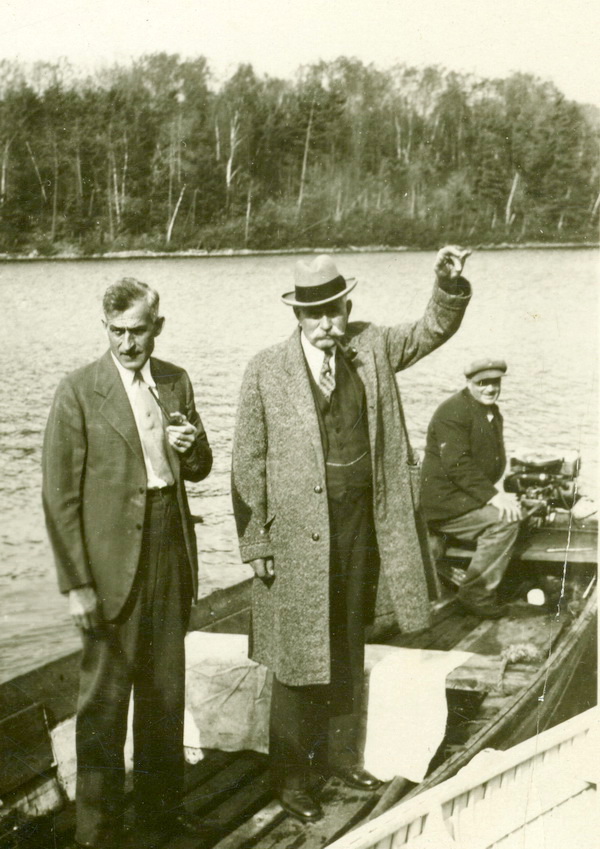
Inniskillin was central to revolutionizing the Ontario wine industry in the 1970s; an industry which had never really recovered from Prohibition and a long, reputation-killing addiction to the Labrusca grape. The latter, reliably hardy in Canadian winters, was used in cheap wines often consumed on the street by members of a couple of generations traumatized by wars or by the internal colonialism of the Canadian settler state, or by both. Inniskillin pioneered new varietals, and the wines produced from them earned a respectable place on urban middle-class tables. One might imagine talk at such tables about 1980 turning to profitable Canadian mining investments in Central and South America, or in Southeast Asia, where Indonesia, purged of several hundred thousand alleged communists, was open for business. Perhaps one of the diners might have mentioned a charitable event in aid of certain refugees the media were calling “boat people,” arriving to make new lives after the ouster of the doomed South Vietnamese regime.
Let’s return in conclusion to that filler article above Walter Duncan’s Minneapolis press cameo, absentmindedly left intact in the clipping. It turned out not to be as prescient as it might have seemed in 1923. By the 1970s, nationalism and national liberation appeared to be ascendant while Empire beat a long, final retreat. But Empire still had tricks up its sleeve and skin in the game. Like Don Duncan, if in far darker ways, it was learning to shed its old martial clothing and move on, re-routing itself to power through financialization and the cultivation of debt dependency, through trade liberalization and multinational joint ventures. And also through cultivation of political leaders who might still talk the talk of liberation but walked the walk of cronyism, or of generals who resurrected the old anticommunist specter in post-coup television speeches about freedom and order: freedom for money (applauded by Chicago economists), and order for people (backed by American, Canadian, European and even Israeli weapons, bought legally or on a surging international black market.)
Also, the multipurpose hunter-killer-intelligence teams Don was sent to assess, assist and improve are still a key implement of today’s warfare, used at times beyond legal and geographical sanction. All major powers have their “special forces.” And for all the advances in distributed computing, artificial intelligence, robotics and long-distance destruction via drone control consoles, civilians are still herded into camps, shot, tortured, conscripted. Soldiers still are sent to battlefields of multinational intervention where there is often no quiet rear; no easy telling of friend from foe. They still come home physically and mentally traumatized, sick from physical, mental and moral injury.
I spent a lot of time on this vignette. How did it come to consume me? From my grandfather’s tales of Walter Duncan, I have the impression that he was jovial, a bit of a practical jokester, liked doing things, was unafraid of ruffling professional feathers, had a penchant for hobnobbing. He liked hunting and fishing; a man’s man. I would have enjoyed listening to his stories, but we would likely have differed on politics. He inhabited a Victorian-masculine moral world I knew but have left; one in which posture (“military bearing”) and ethnic background and firmness counted as virtue, while slouching and second thoughts counted as vice.
Don, I think, knew something of that world. But I knew nothing of him save a name in a family tree till I found his obituary in early 2012, quickly connecting the unknown cousin to the war resister. I’m chuffed at beating The New York Times by four years. But I never experienced and cannot even imagine what he went through in Vietnam. I’m impressed by his courage on and after the battlefield, but distanced by it, too. I’d never make a soldier nor much of a leader.
When his obituary went national in 2016, there were a few comments about his children having lost touch with him for some years. Social media and data banks to the contrary, it’s still easy today to lose touch even with those close to you; perhaps more easy. Damaged people can lose touch or be lost to touch very easily. Those who suffer moral injury sometimes want distance or see it as necessary. I don’t know the circumstances of Don’s latter-day seclusion. I don’t need to know or judge. None of us does.
But his eyes on that Ramparts cover caught me, haunted me. He looks out at us, vulnerable, damaged, questioning, resolute.
I love the man I never met.
![]()
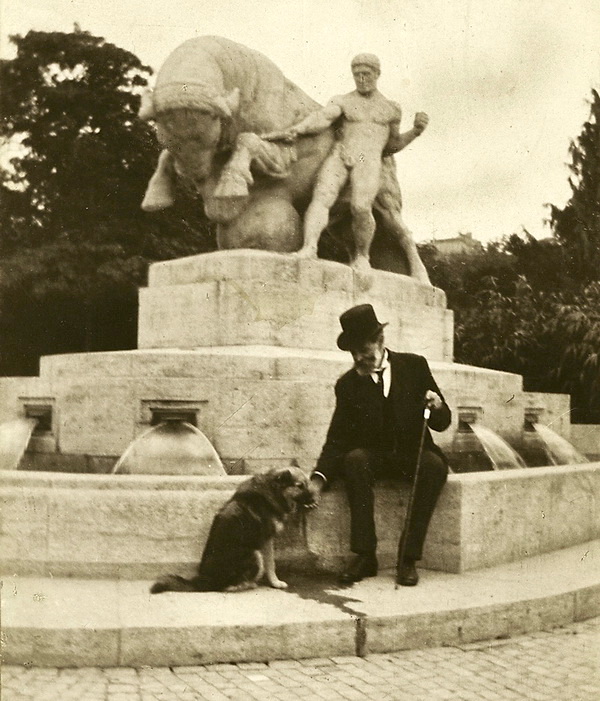
An old man reaches out to stroke the muzzle of a dog at the Geiserbrunnen fountain in the Zürich Bürkliplatz, sometime in the 1920s. What fascinates me about this image is the accidental parallelism in the articulation of the human figures—I don’t think the old man is posed—and their quite opposite effects in relation to the respective animals. I’m also drawn to, and repelled by, the colossal weirdness of the sculptural installation: the brutalist dynamism of the human figure and the bull, stacked on a coffin-like base, which in turn is perched above what looks like a concrete pillbox with water spewing from the gun slits. It was installed before the First World War, and in Switzerland, but it feels like something Il Duce would have unveiled two decades later in yet another annunciation of the New Rome and the end of the effete bourgeois era and all its top-hatted gentlemen.
This particular gentleman had indeed edged close to aesthete circles in the 1890s, and later attempted to sue the Mussolini government for refusing to allow his art collection to leave Italy. It had once been so easy to do that, and so many other cross-border things, back in the days of empires and porous lines on the map and lax officials, before all this fevered nationalism had arisen in the ruins of Old Europe, bringing with it the tiresome exactions of police, document-stamping, and forbiddance.
The photograph is pasted on to a card backing as if it were a studio portrait, but I think it likely to have been blown up from a snapshot taken by the subject’s sister-in-law.
![]()
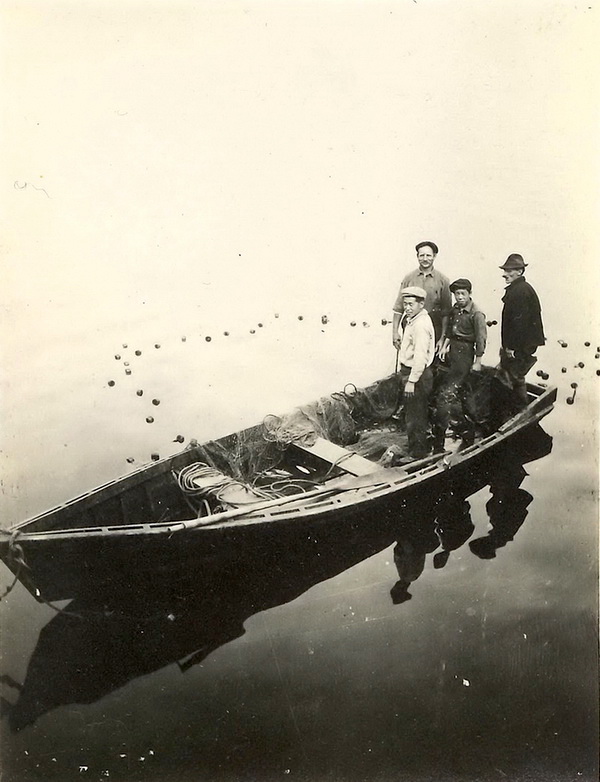
A great-aunt of mine took a train across Canada at some point in the first two decades of the 20th century, and returned with scads of snapshots, only a few of which were ever labelled in albums. She appears to have visited educational institutions and Christian missions on the west coast. None of these preoccupations is surprising: she was a devoutly conservative Presbyterian, dabbled in the Holiness movement, corresponded with missionary friends around the globe, and donated faithfully to mission organizations. She was also an elementary school teacher, an amateur naturalist, a supporter of early conservation initiatives, and an Edwardian lover of uplifting literature, art, and music, including travel narratives. She was what we would now call an “early adopter” of the Kodak Brownie, and used it assiduously, if not always well.
That said, I suspect she may have been given this photo rather than taking it herself. It depicts hand-net fishing, likely on a small commercial scale, somewhere in coastal British Columbia. It has no annotation, so the place, the date, and the identities of the men are lost. One of them, tall, upright, smiles confidently at the camera.
I’m pretty sure two of the other men are of Japanese background. If so, they or their descendants would have been forcibly removed from the coast during the Second World War, relieved of their land, boats, and businesses, interned in camps, and then handed over as cheap labor to prairie farmers. Scores ended up in the beet fields of southern Alberta near Lethbridge, living in terrible accommodation, and banned from the town. All under the pretense of national security, but really because of racism. Decades later, an official apology was offered. Canadian author Joy Kogawa wrote a haunting novel about their ordeal, based on her own and her family’s story. The Galt Museum in Lethbridge, Alberta now features a penitent exhibit of items donated by Kogawa and others. Descendants of the exiles are now prominent members of the community.
Back to these men and their boat. What were their relations to each other? How and why did my great-aunt come to possess a photo of them?
And, above all—I can’t contain my astonishment—how is it possible that four men could stand upright in such a small open boat and manage to keep so still that the water around them is like a sheet of plate glass?
![]()
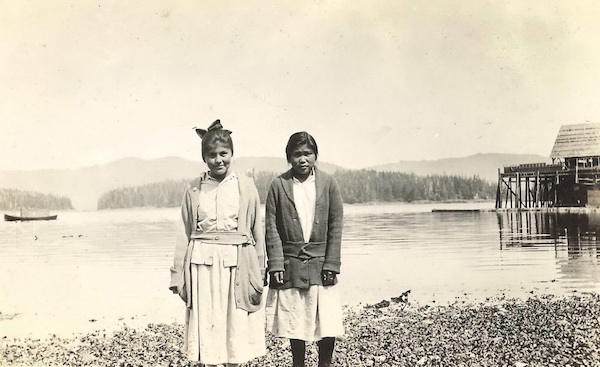
This is another photo that I think was given to rather than taken by a great aunt during her early 20th-century western Canadian trip. Like the one above, it is printed in a larger and wider format than her usual snapshots. It has the matte finish that one often finds on Brownie prints between 1890 and 1920, especially home-developed ones, but it isn’t as dark in tone as many of these, and the image has a clear and regular border. There are no light leaks and no blurring, it’s decently exposed, and the detail at center is reasonably sharp. Still, it’s not a stellar composition. The photographer was a little too far back from the subjects being photographed, yet the “landscape” orientation of the print means their lower legs are cut off while a great deal of extraneous and monotonous background is included. I confess to having cropped the image slightly on the sides, more on the left than the right to keep details of the wharf and its associated structures intact.
Of all the photos I took from the acidified and crumbling shoe box, this one evoked in me a bleak, deep sadness.
Nothing identifies it save a generic pencil note on the back (I am not sure by whom). “Indian laborers,” it says, and it’s hard not to read that as condescending. The names of the two young women are not given; nor that of their nation or clan, nor the kind of work they did, nor when, nor where—though I would guess a British Columbia coastal fish cannery in about 1912. It may document a coastal village or a mission associated with it. I don’t know who took it, who inscribed it, how it came into my aunt’s possession, to whom it was later shown, nor what conversations it might have sparked.
But let’s name it for what it is: an artifact of both casual and institutional racism. Oh yes, we can situate it in its time, take into account the taken-for-granted world of late-Edwardian settler culture, and say that, in a sense, the photographer, the pencil-wielder and the owner of the image knew not what they were doing. Racism then as now was systemic: a web of language and action that made people as much as it was made by them. Racism is less a personal possession than a social system; it possesses its subjects in ways that are hard to see because it also structures their seeing.
And I never heard my great aunt, this great aunt, ever say a disparaging word about indigenous people; if anything, the opposite. I could count on her for a book every Christmas, and in between she sent hand-me-down magazines and other literature about nature, geography, and culture. When she came to visit, I raced to meet her. She was kindly. Here, the family member resists the critic; the settler is unsettled by an accusation, even one not meant personally. Settler and critic meet only on this one point, that racism respects neither victims nor perpetrators. Those who benefit from regimes of European conquest and settlement, whether knowing or unaware, kind or unkind are alike implicated, if in different ways and perhaps degrees. That includes me.
“Oh, Canada,” sang Joni Mitchell, longingly, and one longs for a time when one could still believe innocently in that great but pacific dominion, sea to sea; nation of peacekeepers and legendary politeness; a nation which never had its Indian Wars, its Trail of Tears; its Jacksonian jingoism, its triumphalism, its cotton-planters and slave traders; its gun violence and lynchings. That Good Nation which could look with gentle superiority on its troubled neighbor to the south; that sent troops around the world to keep multilateral peace rather than to extend the imperial designs of an American Century, underwritten by the likes of the United Fruit Company, Standard Oil, ITT, Cargill, Chase-Manhattan, Lockheed, or GM.
It was, and is, all a lie. Like Donald Duncan said about Vietnam. Canada is a lie. And those, like me, who long for it to have been true are those who benefited from the lie, innocently or not.
A lie we share with our neighbor is that the Americas were largely empty when Europeans appeared offshore. Recently, two climate historians at University College London estimated, on the basis of available archaeological, aerial survey, and documentary data, the number of indigenous people killed by the silent waves of disease that swept ahead of the conquistadors, at fifty-five million, 90 percent of the then-existing indigenous population. Many of these were people who farmed extensively, lived in vast cities. The researchers also calculated the climate effects of the reforestation that must have occurred with the decimation of these populations. What they came up with was a carbon sink so vast as to make it a significant cause of the later phase of the Little Ice Age that cooled the entire globe, a little less than a century after this great death.
Any rationalization defending against the dispossession that followed is defeated by the way these young women appear before the lens. Once, it was possible for those who populated the policy making, educational, and helping professions to look at photos like these and not be disoriented. It was possible for some to see here only objects of improvement, and not how the picture-taking was itself part of a darker story: the construction of and resistance to a surreal nationhood. A nation of justificatory fictions, of legislative and institutional impositions at once phantasmagorical and brutally real, with real consequences for souls, bodies, and societies. But no more.
One of the women, appearing more self-possessed and familiar with the process, smiles shyly but engagingly. The other stands as if not knowing how to pose nor even what it means to pose; mute, still, shoulders rounded, hunched, awkward. Awkward to those like me who are used to the visual codes of settler subjectivity; habituated to a corporeal language of self-possession that is the visible code of liberal individualism: how to stand erect, appear definite, show “character” and autonomy and self-possession and a willingness to act; to be a doer not a fusser, not to slouch, not to be passive. Like the Tahitians slagged above Walter Duncan’s press photo, she is exposed in the darkroom of the settler dominion; to blame for what settlers have imposed. She appears as if exiled by these admonitory codes, resigned to discomfort, arms straight in front of her as if held by invisible shackles, as if bound by rope or iron. Compare her stance to that of Red Ryan in the news photo discussed above. There’s a superficial similarity, but hers is not evocatively-posed; there is no penitence drama. Her face is blank; no anger, no resentment, no despair. She is told where to stand, and she stands.
Both are silent before the one we can imagine calling, “Steady now! Smile!”
I try to imagine their lives, what hopes they might have had for themselves, their future children or grandchildren. But the photograph forces me away, boxing these two souls into a carton marked them and then. I’m positioned as if I were the picture-taker; the Liberal Individual taking an image away from their voices, relations, actions, lives, ancestors, community. My looking is implicated.
I share this for their silence, recognizing that it is an artifact of the order my ancestors helped make and that these two women were forced into at great disadvantage. But I also share it to acknowledge what they witnessed, and looking into us, still witness; what their silence now forces into speech: the Great Taking.
If there is now space for voice to inhabit their silence, what would it call?
Give us back our missing and murdered; our bruised, destroyed, humiliated and disappointed; those of ours who were and are lost strangers in their own land. Give us back our walking and eating and hunting and dreaming in this land and on the seas that claim us. We reclaim them from you and your history and photography and examples and professional codes and your capital that eats people and kills land and drains the water from it. And yes, from your sympathy too. We reclaim them in ceremony you banned, around council fires you tried to put out. We reclaim them for the drum and for singing, for animals, plants, people, dreams, for the community on the Turtle’s back, the great gathering that bundles all time and all that is. Turn, walk with us if you have the courage, you, listen to us, help as we ask you to, as we search for and return our lost ones to the circle. Walk with us on this difficult path. Yes, difficult. But we have walked it; we are still walking.
If you will, perhaps then we may speak together.
![]()
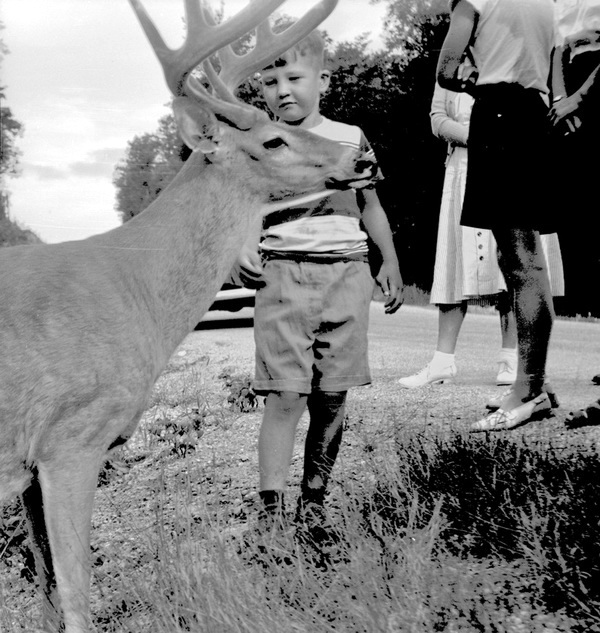
A happy summer’s day at what must have been some sort of nature park, sometime in the 1950’s. But look again; is there not something eerie about this unknown boy, way too close-and-personal with a whitetail stag? It’s a scene that could have come straight out of an art/horror film by the late Canadian artist Jack Chambers, The Hart of London. In fact, this scene could well have been in London, Ontario, a small city I once knew fairly well. Many of my high school classmates went to university there; members of my family had surgery in fine hospitals there. A relatively prosperous, staid town, notable once as the heart of the Canadian insurance industry, for its parks, and for a winding river known, of course, as the Thames. A prosaic place. A respectable place.
And also a place in which heritage structures and places were periodically subject to mysterious arsons; in which developers devastated a downtown; in which serial killers did dark work facilitated by a new superhighway that allowed fast, anonymous entries and exits; in which the peaceful Thames swallowed, over the years, scores of lives of happy boaters and picnickers. A faceted place which some of Canada’s best artists, clear-eyed, claimed as workspace and represented in light and shadow, form and chaos. Like Jack Chambers’ Victoria Hospital, one of the most evocative realist paintings I’ve ever encountered; the great brown building, seen over a space left empty after the War, the place where Chambers received cancer treatment; where I visited beloved members of my own family. Like much of London, the painting is Private Property. But see it. See it, here.
London. Forest City. City of love and fear. I look at this photo, and feel fear at the minor, awed, even loving but also wild, unpredictable encounter it depicts; fenced and chaperoned though it be.
![]()
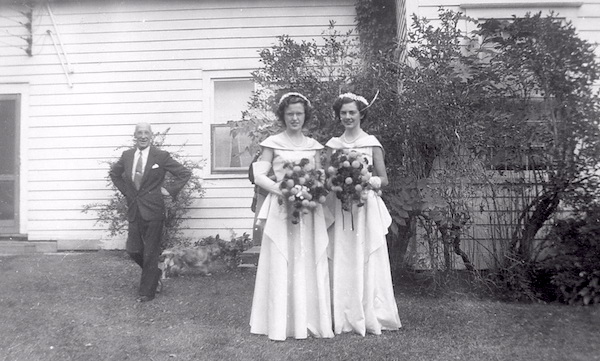
Two members of a bridal party on a lawn either before or after the ceremony. And behind them, another, animated figure: is he about to pounce in a practical joke? Did he stumble, trying to get out of the frame? Did the camera shutter catch his stride just at the exact moment in which he would look inadvertently weird?
At first, I thought I knew who he was: a great uncle of whom I have fond memories; a gentle, kindly man; a tall, ramrod-straight man. We all loved him and looked forward to his occasional visits to stay with his sister, my grandmother.
I saw this picture, and did a slight startle. It made me distinctly uneasy. Look at the contrasts. The two women, apparently dressed in virginal white, standing docile but straight for their picture. The man, darkly-clothed and animated, caught in some mysterious, lurking, pre-pounce movement behind them, where they can’t see. At first glance, eerie, and not in a good way. He is wearing a suit. One doesn’t lurk like that in a suit.
Posture, again. He’s not slouched, but just a bit canted. When men bend or appear at an angle, it can mean humiliation, drunkenness, or threat; up-to-no-good, even if in jest.
I look more closely, and am relieved. It is not my beloved uncle. Nor is it someone else’s drunk uncle. The closer I look, the more apparent it becomes that he was simply walking, perhaps trying to get out of the frame before the shutter is clicked. And instead, he’s caught, embarrassingly. Isn’t it strange that here, as with the intrusive utility pole in the picture of the Farmerettes, the photographer looked through the lens at something, someone, they simply did not see, being so focused on the foreground?
Deeper into the shoe box, I come across another photo of him, this time with a surname; just a “Mr. X.” So, perhaps from the other side of the wedding party, or a family friend I was never cognizant of. In any event, an innocent.
So here again, the reminiscent family member pulls back in discomfort from the surrealist. “The poor man. Let him go. Pull the photo, and your startle.”
Clearly, I didn’t. The surrealist said, “Was there not, at first, quick glance, something creepy about that tall, gaunt figure looming in the background? Inquire!” Indeed, there was and the surrealist won; the family member surrenders with a lame excuse: “The wedding is likely 60, even 70 years past. He’s long dead. I identified no one in the image.”
So here goes: an analysis not of the photo but the startle.
There are two sides to families, and we know that. One is celebrated in fond reminiscences and photo albums, in commemorations and celebrations and reunions, in speeches and in sermons. That is the family as haven in a heartless world; the home you can always go back to or that you want to recreate. The family presented by the advertising industry, in popular sentiment and entertainment, in churches, by middle-class mavens and politicians. But no matter how happy your own family may have been, you will at least have heard other stories about other families, dark hints, whispers. Perhaps you have witnessed moments when hidden, private violence spilled out in some public form; when something was let slip that changed your perception or robbed you of something. Perhaps you sensed secrets in an older relative’s starchy silence, or you became aware of how some family narratives can sand off and varnish the sharp edges of an uncomfortable truth.
Or perhaps your experience of family was, or is, directly, brutally, of that other side.
I’m quite sure the startle the snapshot gave me was inadvertent, coincidental. But if this photograph was and is innocent, the institution of the family—that intimate container of deep love, joy, frustration, boredom, rage, horror—is not and has not been. And so, the slight start this photo triggered is instructive, a reminder. Not all was or is as presented. Not all is seen. Innocence itself is definable only in terms of an opposite which it cloaks or turns from. Innocence, some would argue, is part of a regime of gendered and sexual violence, and its disavowal of that regime is both disingenuous and useful. Like the innocence of White America. Or of Canada, Home and Native Land.
And sometimes, as here, in the smallest of small tragedies, the dark obverse of the regime of innocence briefly entraps, but now as if in amber, one of the situationally blameless.
![]()

This image is a professional studio portrait, reproduced on a green and gilt cabinet card still in good condition. As a material object, it’s worthy of discussion in its own right, but I want to name and focus on the subjects in the image, for reasons that will become clear below.
This is Flora Ross Amos, posed with a slightly eerie-looking baby, her brother, Walter. The year is 1888. They were children of the manse, and Flora was well-schooled, receiving a BA from the University of Toronto and an AM and PhD from Columbia University. Her dissertation, Early Theories of Translation, published by Columbia in 1920, is still significant in its field. (I quoted from it above)
She taught at the College for Women, Western Reserve University, from 1912-19; was briefly an extension instructor at Columbia; then assistant professor of English (ad interim) at the University of Manitoba, 1920-23. She taught two years at Wheaton College, Norton, Massachusetts (where she was required, as an unmarried female, to live in a dormitory); and finally held the John Edgar Memorial Professorship at the women-only Wilson College in Chambersburg, Pennsylvania until 1946.
Her personnel files at Wheaton and Wilson include some interesting documents. In 1923, William H. Hulme of Western Reserve University wrote to the president of Wheaton College that their applicant, Dr. Amos “was unusually well trained in broad scholarship and . . . possesses moreover a genius for accurate research and . . . notable facility in the communication of her thoughts, feelings, and impressions to her students.” Clearly, he was impressed. But he also wrote this: “While she is rather small of stature and not especially beautiful to look at; she is nevertheless attractive . . . she resigned because she was ambitious for more rapid advancement than there was any prospect of her attaining in the immediate future . . . .” A.W. Crawford, of the University of Manitoba wrote: “Her work here was good . . . But the person who holds the place she has been holding with us must necessarily conduct some large classes with Pre-Medical or Pre-Engineering students, or both, and we have thought a man and rather a husky one would do better with such classes . . . she probably did as well as any woman would do with the professional students, who are naturally nearly all men . . .We were prepared to offer her another position which was somewhat junior to the one she has been holding ad interim, but she gave us to understand she did not wish it . . . Dr. Amos was very well liked here . . . especially by the girls in the BA course . . . . ”
I have little documentation of her subsequent life from 1947 until her death in 1966, and have found no memorial to her.
My grandmother, her cousin, saved a 1960 letter from her in which she wrote that she was lame, able to walk slowly only the short street distance necessary to shop for groceries. She was living (alone) “in a very tiny apartment just about at the corner of Lawrence and Yonge” in Toronto. She regretted the deaths of people she once knew, and not having taken opportunities to travel like others “more enterprising” while she still had her health. She invited my grandmother to visit sometime.
There is someone not in this picture: Flora and Walter’s youngest sister, Susie, not born until 1891. Like Flora, she never married. Like Flora, she became a teacher, though not at the university level. Unlike Flora, she continued to reside with her parents. She died young in 1936, and therein lies a tale from her death certificate. Under “cause of death,” the reporting physician notes, “quinsy infection.” Quinsy, a medical term now out of fashion, meant a severe inflammation of the throat, perhaps like those caused by streptococcus, for which there were no antibiotics at the time.
The death certificate form used in 1936 had a second space under “Cause of Death,” headed “Due To.” The physician fills it with crabbed handwriting that spills into the signature space below: “Ten years at least of abdominal & nasal operations and x-ray treatments in the course of prolonged severe neurasthenia. Quinsy was the last straw. A high-strung nervous system that reacted strongly to the worries of teaching, housekeeping & the care of Father & Mother.”
Wow. What a wealth of information in a few lines. Let’s start with the reference to neurasthenia and a high-strung nervous system. Neurasthenia would soon be a term as outdated as quinsy, but for decades from the 1870’s it was a signature mental illness, used to characterize not only individual distress but the state of entire cultures and populations. It was first thought of as a man’s disease (equivalent to hysteria in women) but gradually was generalized in application. Its primary symptoms were nervous excitation combined with exhaustion and lassitude. In men, it was thought of as a threat to national virility, caused by and resulting in constitutional weakness (and weak morals); a disease of the aesthetically-effete and sallow; a contributor to a fall in the birth rate and a reduction in the number of fit recruits for national armies. Poor posture—a caved-in chest, slumping shoulders—and sallow complexion were diagnostic indicators. A fusser was more likely to be called neurasthenic than a doer. Ironically, its diagnosis in women could be more sympathetic, as here.
Second, note the reference to the therapeutic use of x-rays, very common at the time. And finally, note what the doctor observes keenly despite outdated terminology. The symptomatic profile most akin to neurasthenia today is burnout. This woman was not physically well. She was under severe stress from medical treatments that probably did as much harm as good, and from juggling the requirements of employment, housekeeping, and primary care giving for an aged parent (her father had died in 1933).
Susie’s mother died the following year—in Chambersburg, Pennsylvania, where Flora was living. Flora, then, must have taken over her mother’s care.
And brother Walter? I know surprisingly little about him. He married in 1911, was living in Manitoba by 1916, and returned to Toronto at some point between 1933 and 1936. Perhaps his father’s death and the health of his mother and sister had something to do with the move. He alone of the three had a child. He died in 1961, by which time one of his grandchildren had already embarked on a long career in theater and film as an actor, playwright, director and educator, a central figure in alternative, experimental and community theater in Ontario, regional theater in New Brunswick, and the National Theatre School in Montreal. Her name is Janet Amos and she has both a Wikipedia and an IMDb page, as well as an entry in the Canadian Theatre Encyclopedia. I checked to see if Flora had a Wikipedia page. She doesn’t. Maybe someday I should write it . . . .
In closing, I want to make a point of thanking Wanda Finney and Zephorene Stickney, archivists at Wilson and Wheaton College respectively, who searched out and supplied much of the above information about Flora’s career. Writing this biographical vignette made me a little more sensitive to how the scholarly and research work of women has often escaped due recognition.
![]()
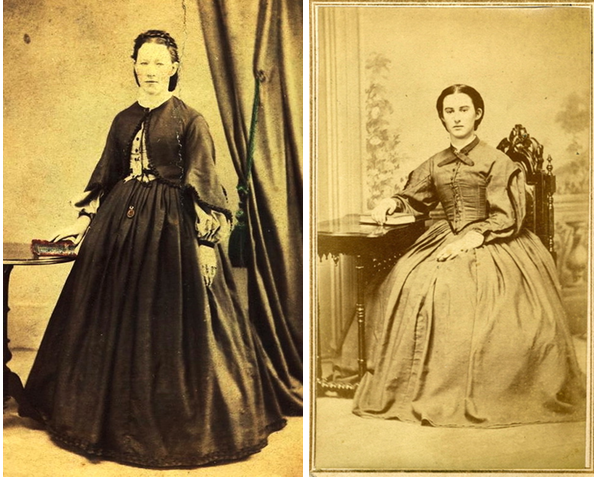
There’s nothing particularly surreal or of larger social significance about these two images. Both are standard studio photos in a carte-de-visite format, a little larger than today’s standard business card, and popular from the 1860’s to the 1880’s. There’s no name written on either, and neither was in an album. They are the sort of generic image from which one can read off and date clothing styles and photographic conventions.
I include the one on the left because I don’t know who she is, but I do know what family line she comes from, though I know that only from her facial features. Well, from her face and from a certain kind of ruminative talk I heard as older people in my family, now dead, did what I am doing now, go through a box of photos. Talk that made lines along which they could connect people, events, narratives.
In my parents’ and grandparents’ day, facial and other physical similarities were thought to provide valid and convincing evidence of relationship. This was a cultural legacy of phrenology and eugenics; a pervasive belief that physical, behavioral and emotional characteristics, along with madness and criminality, were physically heritable and visible. My grandfather was certain that aptitudes and attitudes followed family lines; I can imagine him saying confidently that Walter Duncan, and Cameron and Don, had military or detective blood in their veins, and likely a military bearing in their posture. In The Hound of the Baskervilles, physician-author Arthur Conan Doyle (who shared a mutual friend and mentor with the old man reaching out to the dog at the Zurich fountain) had Sherlock Holmes identify a murderer by contemplating a line of ancestral portraits. The Victorian scientist Francis Galton went so far as to assemble a photographic gallery from which he thought he might be able to synthesize heritable “types.”
Knowing the fate of eugenics, I should know, then, to be cautious about attributing identity to this figure. I think, though, that I want to claim her back less to a family line than into a community of ancestral witnesses; to make her image no longer orphan. This whole column has been, in a sense, about reclaiming a sort of relational web; a community. But I still fall back on the face to do so.
And then there is the image on the right. Here, I am adamant. I am absolutely certain who she is, without any corroborating evidence, and my vehement certainty fascinates me. She is, I tell you, my great grandmother, born in the late 1840s. She died of breast cancer 20 years before I was born. I have not a single line of anything she wrote; not a recipe, not a letter, not a diary entry. Nothing but a few other identified photos and some oral history (she was a fearsome scrubber of small grandsons’ ears).
Yet I know it is her. I’d know that face anywhere. Her personality is there in spades. There where? How can I say that? How can I know and have such an affinity for a woman I never met; of whom even my mother, as a toddler, had only one vague memory? I can’t say. All I know is that I’m sure it’s her, just as sure as she is of herself in this photo. She inhabits herself with a poise evident in every other picture of her youth, and she isn’t taking any guff from you about it. It’s in her stance (no slouch!) and in her face, which only seems expressionless.
What is it, asks the critical cultural analyst; what is it about the face and about posture that made it so easy for generations not only to read family lines into them, but to read into them a personality, a character, an affinity? What about them makes them appear to be the privileged loci and most eloquent signifiers of liberal individualism: its interiority, its agency, its moralized autonomy? How did they become sure vessels of personal knowledge and primary avenues for its manifestation? How have they come to be taken for granted, by journalists and photographers, by relatives and friends, and also, especially even, by police and bureaucrats?
Well.
If I have supposed correctly in my stubbornness, her name is Elspeth, the year is about 1867, and the studio was in Port Hope, Ontario.
She would go on to have three sons and a daughter. The eldest brother, sensitive and troubled, steeled himself to become a fearsome preacher, farmer, agrarian political leader, and head of the largest farm co-operative organization in the province. He supported the first Canadian woman to make her mark in national politics, even as his own wife labored under his dour distance. A second son, modest and easier to know, dedicated himself to service in local organizations, though his wife was a firebrand president of the United Farm Women of Ontario during their heyday in the early 1920’s. The third became an agent with Massey-Harris. Strangely, I know the least about his life, but the most about him as a person. He was a gentle soul; a listener, kindly to children, giving them small bits of digestible advice. He was admired for having the straightest posture of anyone in the family, but my favorite memory is of him sitting at the bottom of a staircase to admire a baby tooth I’d just pulled. He died one summer when I was still very young, in a bedroom under the window of which I was admonished to play quietly. He was my first old-people favorite. He was also the figure I at first thought to have been captured by a camera, lurking behind the bridesmaids.
And the fourth and youngest was a child who was her three brothers’ pet, my grandmother Maggie.
![]()
References
“. . . what a blue glass bead retrieved from a mound of excavated dirt might say about manufacturing techniques, trade routes, self-decoration, even politics . . .”
- See William Ramp, “Trash Talk,” Weekly Hubris, July 31, 2017. https://weeklyhubris.com/trash-talk/
“These govern the practical production of what counts as legitimate scholarship, authorship and truth in particular times and places.”
- See Michel Foucault, “What is an Author?” in Donald F. Bouchard, ed., Language, Counter-Memory, Practice: Selected Essays and Interviews by Michel Foucault (Cornell University Press, 1980); also online at https://www.open.edu/openlearn/ocw/pluginfile.php/624849/mod_resource/content/1/a840_1_michel_foucault.pdf
- See also Dorothy E. Smith, “The Social Construction of Documentary Reality,” Sociological Inquiry 44(4), 1974
“. . . like Max Weber (and St. Paul, who “saw through a glass darkly”) . . .”
- Max Weber, “Science as a Vocation,” trans. of ‘Wissenschaft als Beruf,’ in Gesammlte Aufsaetze zur Wissenschaftslehre (Tubingen, 1922), 524‐55. First given as a speech at Munich University, 1918. http://www.wisdom.weizmann.ac.il/~oded/X/WeberScienceVocation.pdf
- Paul, First Letter to the Corinthians, 13:12, KJV.
“Both tend to discourage scholarship with a potential to discomfit, or learning from failure,” … “It makes of ‘innovation’ more of the same . . .”
- My favorite example of learning from failure is Kieran Bonner’s account of his research on attitudes toward safety and child-rearing in a rural community, in A Great Place to Raise Kids: Interpretation, Science, and the Rural-Urban Debate (McGill-Queen’s University Press, 1997)
- On “more of the same,” see David Graeber, The Utopia of Rules: On Technology, Stupidity, and the Secret Joys of Bureaucracy (Melville House, 2015), esp. chapter 2
“. . . called, with astounding technocratic hubris, “ecosystem services . . .”
- See Wikipedia, “Ecosystem Services” https://en.wikipedia.org/wiki/Ecosystem_services
- See also William Ramp, “Complicating food security: Definitions, discourses, commitments,” Canadian Studies in Population 41(3-4), 2014, esp. pp. 125-6. https://journals.library.ualberta.ca/csp/index.php/csp/article/view/18575
“. . . an inexplicable die-off of a remote species . . .”
- “200,000 endangered Antelope Died. Now We Know Why.” Weird & Wild, National Geographic, January 29, 2018. https://news.nationalgeographic.com/2018/01/saiga-antelope-killed-bacteria-2015-mass-die-off-central-asia-spd/
“. . . a flicker of everyday ‘ugly feelings’ . . .”
- Sianne Ngai, Ugly Feelings (Harvard University Press, 2007)
“There is a legitimate mode of inquiry called abduction . . .”
- See Carlo Ginzburg and Anna Davin, “Morelli, Freud and Sherlock Holmes: Clues and Scientific Method,” History Workshop 9 (1980). http://users.clas.ufl.edu/burt/filmphilology/ginzburgmorellifreudholmes.pdf
“Ralph Eugene Meatyard took scores of images that look like weird and badly-composed family photos but were in fact meticulous visual compositions . . .”
- See David Zax, “Ralph Eugene Meatyard: The Man Behind the Masks,” Smithsonian Magazine, November 2011: https://www.smithsonianmag.com/arts-culture/ralph-eugene-meatyard-the-man-behind-the-masks-106625198/#R6wXlsgXIKJD1lD3.99
- See also “Ralph Eugene Meatyard,” International Centre of Photography https://www.icp.org/browse/archive/constituents/ralph-eugene-meatyard?all/all/all/all/0
- See also Ralph Eugene Meatyard (Barry Magid, ed.), Father Louie: Photographs of Thomas Merton (Timken Publishing, 1991)
“Realism, said Mark Fisher, is not the Real … for intimations of the Real, attend to its apparition as the weird before you and within you.”
- See Mark Fisher, Capitalist Realism: Is There No Alternative? Zero Books, 2009, and also Fisher, The Weird and the Eerie, Repeater Books, 2017.
- See also Roger Luckhurst, “Making Sense of The Weird and the Eerie,” Los Angeles Review of Books, March 11, 2017, especially this: “The uncanny, Fisher says, puts the ‘strange within the familiar’ and ‘operates by always processing the outside through the gaps and impasses of the inside.’ In other words, for all its interest in boundary breaches, it is still centered on the self. The weird and the eerie work at this from the other direction, Fisher suggests: ‘they allow us to see the inside from the perspective of the outside.’ The weird is a disturbing obtrusion of something from the outside in. It is the insidious intrusion, the confounding juxtaposition, the thing found in the wrong place.” https://lareviewofbooks.org/article/making-sense-of-the-weird-and-the-eerie/#
“. . . material ghosts, palimpsests that disturb the here-and-now that is the conceit both of normal life and of the everyday photograph.”
- See Avery F. Gordon, Ghostly Matters: Haunting and the Sociological Imagination,” University of Minnesota Press, 2008.
- See also Emily F. Kirbyson, “Hauntings on Blackfoot land: Theorizing the hinterlands of Native teacher education programming at the University of Lethbridge,” M.A. thesis, Department of Sociology, The University of Lethbridge, 2017. https://opus.uleth.ca/bitstream/handle/10133/5008/KIRBYSON_EMILY_MA_2017.pdf?sequence=3&isAllowed=y
“This kind of attention works particularly well as an element of creative and material practices such as collage or bricolage.”
- Collage can be thought of as an application of juxtaposition to imagery, and the related practice of bricolage as a similar process applied to three-dimensional objects and even ideas. Aby Warburg’s unfinished Mnemosyne Atlas was a more focused and even didactic project than what I have in mind here, but it shares the same spirit in the sense that Warburg constructed it without explanatory labels, leaving viewers freedom to respond, both cognitively and affectively, in varied ways. Joseph Cornell’s framed and boxed collections of minor objects provide an example of a sort of bricolage which is best read not as indicating some mysterious and occulted meaning but as the possibility of a transformative encounter.
- On Warburg’s Mnemosyne Atlas, see Christopher D. Johnson, “About the Mnemosyne Atlas,” Mnemosyne: Meanderings through Aby Warburg’s Atlas, Cornell University Library. https://warburg.library.cornell.edu/about
- See also “The Mnemosyne Atlas, October 1929,” The Warburg Institute. https://warburg.sas.ac.uk/collections/warburg-institute-archive/bilderatlas-mnemosyne/mnemosyne-atlas-october-1929, and also “Thinking With Pictures,” Goethe Institut: https://www.goethe.de/en/kul/bku/20867100.html
- On Joseph Cornell, see “Joseph Cornell,” Collections Online, The Guggenheim Museum, https://www.guggenheim.org/artwork/artist/joseph-cornell, and also “The Joseph Cornell Box,” https://www.josephcornellbox.com/
- See also Mary Ann Caws, ed., Joseph Cornell’s Theater of the Mind: Selected Diaries, Letters, and Files (Thames & Hudson, 1994)
“The Surrealist movement used collage to unsettle and disarrange perceptual conventions and categorical distinctions with the aim of making possible new modes of social and psychological inquiry . . .”
- See Derek Sayer, Making Trouble: Surrealism and the Human Sciences (University of Chicago/Prickly Paradigm Press, 2017); also Prague, Capital of the Twentieth Century: A Surrealist History (Princeton University Press, 2013)
“Walter Benjamin suggested in the 1920’s that the proliferation of amateur photography . . .”
- Walter Benjamin, “The Work of Art in the Age of Its Technological Reproducibility,” in Benjamin (M. Jennings, B. Doherty & T. Levin, eds.), The Work of Art in the Age of Its Technological Reproducibility and Other Writings on Media (Harvard University Press, 2008)
“Even Foucault, advocate of counter-memory, pursued it through ‘grey, meticulous and patiently documentary’ work . . .”
- Michel Foucault, “Nietzsche, Genealogy, History,” in D. F. Bouchard, ed., Language, Counter-memory, Practice: Selected Interviews and Essays by Michel Foucault. Cornell University Press, 1977, 139
“But his intellectual and political baptism made him the twentieth century’s own . . .”
- Wessel Krul, “In the Mirror of van Eyck: Johan Huizinga’s The Autumn of the Middle Ages,” Journal of Medieval and Early Modern Studies 27(3), 1997. http://users.clas.ufl.edu/burt/Medieval%20cinema%20recommended/Huizinga.pdf
“I wrote once in a Weekly Hubris column of how my father’s outlook on political morality was shaped by his experience of Nazi occupation . . .”
- See William Ramp, “An Admonition,” Weekly Hubris, March 23, 2016. https://weeklyhubris.com/an-admonition/
“It admits to but assaults difference.”
- This is a Derridean point, or at least one in concert with my reading of Derrida as a careful, disciplined scholar whose work bears no resemblance to the allegedly-destructive postmodernism his culture-war critics all too often claim he fostered. See J. L. Kruger, “Translating traces: Deconstruction and the practice of translation,” Literator 25(1), 2004. https://literator.org.za/index.php/literator/article/download/245/218
“ . . . interpretive purpose is conditioned by the very difference it wishes to bridge: in context, readership, horizons of expectation.”
- See Hans-Robert Jauss, Toward an Aesthetic of Reception, tr. T. Bahti. University of Minnesota Press, 1982. However, my regard for Jauss’s scholarship in the 1980’s must now of necessity be accompanied (in this period of rising neo-fascism) by the results of a 2014 investigation into his wartime SS membership. See Jens Westemeier, Hans Robert Jauss: Jugend, Krieg und Internierung. Konstanz: Konstanz University Press, 2016; also Joachim Güntner, “Sturmführer und Romanist,” Neue Zürcher Zeitung, 21 May 2015. https://www.nzz.ch/feuilleton/sturmfuehrer-und-romanist-1.18545990
“Traduttore, traditore (translator, traitor) runs the Italian proverb.”
- See Maria Khodorkovsky, “Traduttore, Traditore,” Beyond Words – Language Blog, ALTA, October 9, 2008. https://www.altalang.com/beyond-words/traduttore-traditore/
- See also Eduardo Kahane, “Traduttore Traditore: From aesthetic approach to social stigma,” aiic.net October 27, 2016. https://aiic.net/page/7790/
“Amos concluded that the translator should ‘look upon translation as a promising experiment, rather than a doubtful compromise’.”
- Quote is from Flora Ross Amos, Early Theories of Translation (Columbia University Press, 1920; repr. Octagon Books, 1973), xi-xiii. http://www.gutenberg.org/files/22353/22353-h/22353-h.htm
“. . . in much the same spirit as the image-only sections of John Berger’s classic Ways of Seeing.”
- John Berger, Ways of Seeing (Penguin, 1972)
“There’s now a young-adult novel…about Canadian farmerettes.”
- Gisela Tobien Sherman, The Farmerettes (Second Story Press, 2015). See also https://www.umanitoba.ca/cm/vol21/no26/thefarmerettes.html
“. . . a book about 4-H that unsettles the history of that beloved rural youth organization, making it seem, at times, quite surreal . . .”
- See Gabriel N. Rosenberg, The 4-H Harvest: Sexuality and the State in Rural America (University of Pennsylvania Press, 2015)
“Go look at the Wikipedia page for the Little Mermaid of Copenhagen.”
- See The Little Mermaid (statue) on Wikipedia, https://en.wikipedia.org/wiki/The_Little_Mermaid_(statue)
“This particular weapon was given up by an eager town council during the Second World War . . .”
- The town square in question is in Port Dover, Ontario; its history and that of its guns has been mentioned in various local histories and discussed on a Facebook page, “If You Grew Up In Port Dover, Do You Remember When?” https://www.facebook.com/groups/250532041643829/
“. . . a 1920s imagist prose poem by Raymond Knister came to mind…”
- Quoted material excerpted from Raymond Knister, “Poisons,” in G. Betts, ed., After Exile: A Raymond Knister Poetry Reader (Holsten, ON: Exile Editions, 2011)
“. . . a place where one is supposed to feel a little different; a liminal point.”
- On the anthropological concept of liminality, see above all, Victor Turner, The forest of symbols: Aspects of Ndembu ritual. Cornell University Press, 1967, and also Turner, The ritual process: Structure and anti-structure. Aldine, 1969.
“The Roman god Terminus lent his name to boundary markers at which sacrifices were made . . .”
- See Emile Durkheim, Professional Ethics and Civic Morals, tr. C. Brookfield. The Free Press, 1958, 150-55. https://archive.org/details/professionalethi00durk/page/154
“. . . there is something about them that Foucault termed heterotopian; a quality of ‘other spaces.’”
- Michel Foucault, “Of Other Spaces: Utopias and Heterotopias,” from Architecture /Mouvement/ Continuité, October, 1984 (“Des Espace Autres,” March 1967, tr. J. Miskowiec). http://web.mit.edu/allanmc/www/foucault1.pdf
“. . . on his way to becoming one of the most famous men in Canada for his exploits on both sides of the law; flamboyant bank robber, colorful penitent, and astonishing recidivist.”
- See Peter McSherry, The Big Red Fox: The Incredible Story of Norman “Red” Ryan, Canada’s Most Notorious Criminal (Dundurn Press, 1999)
“He got in the papers for declaring war on ‘loafers’ in 1905 . . .”
- “War on Loafers,” Toronto Daily Star, November 28, 1905, copy provided to me by William (Bill) Mills.
“. . . corralled draft-evaders during the Great War.”
- “Township Resident passes,” Niagara, Ontario 1934. For other biographical details see coverage of the Ryan arrest and incarceration in the Toronto Daily Star, January 9, 1924, p. 4; also “Duncan Calls Bureau Liquor Law Violator,” Toronto Daily Star, April 27, 1926, p. 1; and “Ex-Inspector Duncan Passes in 71’st Year, Toronto Daily Star, Nov. 22, 1934, p. 3. Copies of all these news stories courtesy of William (Bill) Mills.
“Walter’s only son, Cameron, served in the naval volunteer reserve during the First World War as a radio telegraph operator on HMCS Acadia . . .”
- “Duncan, Walter Cameron Cruickshank,” entry in list of graduates, University of Toronto, n.d., p. 256. Copy supplied to me by Bill Mills. See also W. C. C. Duncan’s naval service record summary in Library and Archives Canada, “Service Files of the Royal Canadian Navy, 1910-1941 – Ledger Sheets,” Vol. 27: RG 150 1992-93/170, Item 288
“Acadia, a former survey vessel, was assigned to antisubmarine patrols . . . She was in Halifax harbor December 6, 1917 when . . .”
- See “CSS Acadia,” Maritime Museum of the Atlantic. https://maritimemuseum.novascotia.ca/what-see-do/exhibits/css-acadia
- See also Michael Gorman, “Nova Scotia repairing only ship still afloat to survive Halifax Explosion,” CBC News, December 6, 2018. https://www.cbc.ca/news/canada/nova-scotia/css-acadia-repairs-restoration-1.4934917
“. . . a four-footed Rodent Control Officer named Erik The Red.
- Carolyn Ray, “Erik the Red to retire from rodent control officer duties on CSS Acadia,” CBC News, August Aug 14, 2015. https://www.cbc.ca/news/canada/nova-scotia/erik-the-red-to-retire-from-rodent-control-officer-duties-on-css-acadia-1.3191288
“His 1922 graduation entry in Torontonensis . . .”
- Torontonensis, Vol. XXIV. The University of Toronto, 1922, p. 201. Via Internet Archive. https://archive.org/details/torontonensis22univ/page/200
“Cam received a government title that weirdly echoed his father’s: Radio Inspector for the province of Ontario . . .”
- “First Radio ‘Cop’,” Lethbridge Daily Herald, Lethbridge AB, June 17, 1922. Copy of clipping courtesy of Bill Mills.
“. . . was already on her way to Hollywood stardom under the name Mitzi Gaynor). Norma’s elder son, Donald Walter Duncan, also moved south . . .”
- Don had a brother, Bruce, who predeceased him. Bruce may also have moved to the States after his father’s death, but I have no information about him beyond his first name. Details of Don’s early and late life are also scarce; a few facts can be found in and inferences made from his own writings, various online pocket biographies, and obituaries in the Madison Courier-Journal (2009) and the New York Times (2016): see Robert D. McFadden, “Donald W. Duncan, 79, Ex-Green Beret and Early Critic of Vietnam War, Is Dead,” New York Times, May 6, 2016. https://www.nytimes.com/2016/05/07/us/donald-w-duncan-79-ex-green-beret-and-early-critic-of-vietnam-war-is-dead.html
- There are also biographical details in Don’s (heavily-redacted) FBI file online: see “Full Text of Donald Duncan,’” on Internet Archive: https://archive.org/details/DonaldDuncan
- See also a partial military service file, online at “Donald Duncan,” Medic in the Green Time. http://medicinthegreentime.com/wp-content/uploads/2016/08/PDF.pdf
- For biographical information on Mitzi Gaynor, see her Wikipedia entry, and also her personal Web page at http://missmitzigaynor.com/
“DELTA’s mission included operational and strategic reconnaissance . . .”
- “Project Delta, Wikipedia. https://en.wikipedia.org/wiki/Project_DELTA
“It was the perfect setup for a convinced enemy of communism and a highly-trained soldier . . .”
- See Donald W. Duncan, “The whole thing was a lie!” Ramparts, 4(10), February 1966. This article, as a whole or in part, has been posted online at a number of sites, including the content archive of Unz Review: http://www.unz.com/print/. See also the biographical references above.
“. . . one of whom took him to the offices of a Catholic anti-war magazine with a growing circulation, called Ramparts.”
- See “Remembering Donald W. Duncan: From Gung-Ho Green Beret to Outspoken Opponent of U.S. Crimes in Vietnam,” Revolution, May 23, 2016. https://revcom.us/a/440/remembering-donald-duncan-en.html
“When the February 1966 issue of Ramparts hit the stands . . .”
- The cover image of this issue is widely reproduced online. See “Image Credits” below for my usage of it. Duncan authored the cover story: see Duncan, “The whole thing was a lie!” Ramparts 4(10), February 1966.
“The sociologists Emile Durkheim and Robert Hertz . . . noted that sacred things can switch polarities and remain sacred.”
- See Emile Durkheim, The Elementary Forms of Religious Life, trans. K. E. Fields. Free Press, 1995, esp. chapter 5, IV, pp. 387-391. See also Robert Parkin, The Dark Side of Humanity: The Work of Robert Hertz and its Legacy, Routledge, 1996, esp. chapter 4, “Right and Left.”
“Don’s Ramparts cover story blew the lid off the endemic corruption and intelligence failures . . .”
- See Duncan, “The whole thing was a lie!” cited above; also Duncan, The New Legions, cited below. The biographical sources cited earlier also contain relevant detail. The CIA archived some of it: search under “Library” at the CIA site, e.g. https://www.cia.gov/library/readingroom/search/site/%22Donald%20Duncan%22
He wrote a book detailing how the war had travestied human rights and truth. He appeared before an international inquiry . . .”
- Donald Duncan, The New Legions. Random House, 1967.
- See also “10 Donald Duncan: Testimony and Questioning,” in Prevent the Crime of Silence: Reports from the sessions of the International War Crimes Tribunal founded by Bertrand Russell. Selected and edited by Peter Limqueco and Peter Weiss with additional material selected and edited by Ken Coates and a Foreword by Noam Chomsky. Bertrand Russell Peace Foundation Ltd., 1971. Online at time of writing, at http://www.fcmm.ecoscientific.ca/warcrimes/!clickme.htm
“. . . and in that capacity, reviewed a biography of General Westmoreland . . .”
- Donald Duncan, “Ever a general, never a boy: Westmoreland: The Inevitable General, by Ernest B. Furgurson,” Ramparts, November 30, 1968, p. 64
“. . . and even a perhaps-sympathetic Indiana FBI agent tasked with checking on him . . .”
- See his FBI file, “Full Text of Donald Duncan,’” Internet Archive. https://archive.org/details/DonaldDuncan
“Aside from an appearance in the Vietnam resistance documentary Sir! No Sir! . . .”
- Now distributed by Displaced Films: see http://www.displacedfilms.com/films/sir-no-sir/
“Even The New York Times didn’t find out about his death for seven years, until 2016.”
- See also William McDonald, “An Obituary Runs Seven Years After the Subject’s Death. What Happened?” The New York Times, May 25, 2016. https://www.nytimes.com/2016/05/25/insider/an-obituary-runs-seven-years-after-the-subjects-death-what-happened.html
“The place later became Inniskillin Estate Winery, and named one of its signature wines after Walter’s Scottie dog.”
“They still come home physically and mentally traumatized, sick from physical, mental and moral injury . . . Those who suffer moral injury sometimes want distance or see it as necessary.”
- See Michael D. Matthews, “Moral Injury: Toxic Leadership, Maleficent Organizations, and Psychological Distress,” Psychology Today, March 10, 2018. https://www.psychologytoday.com/ca/blog/head-strong/201803/moral-injury
- See also William P. Nash and Brett T. Litz (2013), “Moral Injury: A Mechanism for War-Related Psychological Trauma in Military Family Members.” Clinical Child and Family Psychology Review 16:365–375. https://s3.amazonaws.com/academia.edu.documents/34660225/Nash_Litz_2013.pdf?AWSAccessKeyId=AKIAIWOWYYGZ2Y53UL3A&Expires=1549861056&Signature=yGb4lctqWjADv4ChWO1GpyP%2BK50%3D&response-content-disposition=inline%3B%20filename%3DMoral_injury_in_military_families.pdf
“Canadian author Joy Kogawa wrote a haunting novel about their ordeal . . .”
- Joy Kogawa, Obasan. Lester & Orpen Dennys, 1981.
“Oh, Canada,” sang Joni Mitchell, longingly . . .”
- Joni Mitchell, “A Case of You,” on Blue, 1971.
“Recently, two climate historians at University College London estimated . . . the number of indigenous people killed . . .”
- Chris Brierley, Mark Maslina, Simon Lewis, “Earth system impacts of the European arrival and Great Dying in the Americas after 1492,” Quaternary Science Reviews, 207 (2019):13-36. https://www.sciencedirect.com/science/article/pii/S0277379118307261
“. . . habituated to a corporeal language of self-possession that is the visible code of liberal individualism . . .”
- See Elizabeth A. Povinelli, Geontologies: A Requiem to Late Liberalism. Duke University Press, 2016; also Economies of Abandonment: Social Belonging and Endurance in Late Liberalism. Duke University Press, 2011, and The Empire of Love: Toward a Theory of Intimacy, Genealogy, and Carnality. A Public Planet Book. Duke University Press, 2006.
“. . . an art/horror film by the late Canadian artist Jack Chambers, The Hart of London . . .”
- See “The Hart of London,” Wikipedia. https://en.wikipedia.org/wiki/The_Hart_of_London
- See also “Jack Chambers, life & work by Mark Cheetham, ‘The Hart of London, 1968-70.’” Art Canada Institute. https://www.aci-iac.ca/art-books/jack-chambers//key-works/the-hart-of-london
“. . . in which serial killers did dark work facilitated by a new superhighway . . .”
- See Jared Lindzon, “What turned one city in Canada into the ‘serial killer capital’ of the world?” The Guardian, 19 August 2015. https://www.theguardian.com/world/2015/aug/19/serial-killer-london-ontario-canada
- See also Michael Arntfield, Murder City: The Untold Story of Canada’s Serial Killer Capital, 1959-1984. FriesenPress, 2015.
“Like Jack Chambers’ Victoria Hospital, one of the most evocative realist paintings I’ve ever encountered . . .”
- Jack Chambers, Victoria Hospital, 1969-70, oil on wood, 121.9 x 243.8 cm. Private collection. https://www.aci-iac.ca/art-books/jack-chambers//key-works/victoria-hospital
“He is wearing a suit. One doesn’t lurk like that in a suit.”
- John Berger, “The Suit and the Photograph,” in Berger, About Looking. Vintage (reprint), 1992.
“Her name is Janet Amos and she has . . . an entry in the Canadian Theatre Encyclopedia.”
- See “Amos, Janet,” Canadian Theatre Encyclopedia. http://www.canadiantheatre.com/dict.pl?term=Amos%2C%20Janet
“The Victorian scientist Francis Galton went so far as to assemble a photographic gallery from which he thought he might be able to synthesize heritable ‘types’.”
- See “Francis Galton and Composite Portraiture,” Galton.org. http://galton.org/composite.htm
- See also Suzanne Bailey, “Francis Galton’s Face Project: Morphing the Victorian Human,” Photography and Culture, 5(2), 2012 (online 2015). https://www.tandfonline.com/doi/abs/10.2752/175145212X13330132507077
![]()
Image Credits
Image 1. Photo by Zuzanna Dolega, uploaded to Wikimedia Commons 19 Jan. 2019, of a collage, presumably also by Dolega. Bringing together traditional and digital collage, the latter work is a remix combining tissues of burned paper, with a digitally-modified photograph by Narcyz Witczak-Witaczyński (1898-1943), National Digital Archive 107-313-1. Dolega uses photographic and other materials in a process of digital interference as part of an exercise in analyzing collections made available by cultural institutions, combining selected material into thematic groups, and building dialogue between them: placing them in a different context, mapping connections, creating contrasts and new meanings.
(Zuzanna Dolega (b. 1990, Gdynia) is a graduate of the Faculty of Painting at the Academy of Fine Arts in Gdańsk and a PhD student at the Academy of Fine Arts in Gdańsk. Since 2012, she has specialized in the technique of pyrography, along with issues related to collage, neuroesthetics and art therapy.)
Image shared under Creative Commons Attribution-Share Alike 4.0 International license https://commons.wikimedia.org/wiki/File:Miesz(k)aj%C4%85c_(w)_przesz%C5%82o%C5%9Bci_-_3_dziewczynki.jpg
Image 2. Author photo, 2016
Image 3. Robert Delaunay illustration, cover of Yvan Goll’s Surréalisme, Manifeste du surréalisme, Volume 1, Number 1, October 1, 1924. Photo by Blue Mountain Project on Wikimedia Commons. Public domain. https://commons.wikimedia.org/wiki/File:Yvan_Goll,_Surr%C3%A9alisme,_Manifeste_du_surr%C3%A9alisme,_Volume_1,_Number_1,_October_1,_1924,_cover_by_Robert_Delaunay.jpg
Image 4. Elías García Martínez (1858–1934), “Ecce Homo,” Santuario de la Misericordia, Borja, before attempted restoration. Photo on Wikimedia Commons; assumed to be by Centre de Estudios Borjanos, 2010 (see http://epdlp.com/cuadro.php?id=4316). See Wikimedia Commons entry at https://en.wikipedia.org/wiki/Ecce_Homo_(Mart%C3%ADnez_and_Gim%C3%A9nez,_Borja)#/media/File:Elias_Garcia_Martinez_-_Ecce_Homo.jpg
Image 5. Attempted restoration by Cecilia Giménez of the fresco “Ecce Homo” by Elías García Martínez, on Wikimedia Commons via New York Times, 2012 (https://www.nytimes.com/2012/08/24/world/europe/botched-restoration-of-ecce-homo-fresco-shocks-spain.html). The restored fresco is assumed to be copyrighted by the artist, Cecelia Giménez, who is still living. The image is used here under a Minimal use provision (WP:NFCC#3): The image is used in this article only to illustrate issues of context and preconception as they relate to restoration or alteration of works of art. It is presented here in a low resolution to reduce the likelihood of copying and has been cropped to show only the attempted restoration. See https://en.wikipedia.org/wiki/Ecce_Homo_(Mart%C3%ADnez_and_Gim%C3%A9nez,_Borja)#/media/File:Attempted_restoration_of_Ecce_Homo.jpg
Image 6. Head of Saint John the Baptist on a Charger, School of Nottingham, 15th century. Metropolitan Museum of Art, public domain. https://www.metmuseum.org/art/collection/search/463607
Image 7. Tim Collins, “Modern bedroom, Victoria, Australia,” 2010, via Wikimedia Commons. Shared under Creative Commons Attribution-Share Alike 3.0 Unported license. https://commons.wikimedia.org/wiki/File:Bedroom_Mitcham.jpg
Images 8 to 10. Author collection (courtesy of Mrs. A. McMillan, Nanticoke, ON)
Image 11. Author collection
Image 12. Public domain. From “Full text of ‘Torontonensis, 1922,’” Internet Archive. https://archive.org/details/torontonensis22univ/page/200
Image 13. Public domain: originally from Canadian Navy Heritage website, image negative no. H-558a (link no longer live). The image as it appears here was sourced from Wikimedia Commons. See https://commons.wikimedia.org/ewiki/File:HMCS_Acadia_H-558a.jpg
Image 14. The photograph of Donald W. Duncan used on the February 1966 cover of Ramparts was taken by Erik Weber and is reproduced here with his permission. For more on Weber’s career and photography, see www.desart.com . For Image 14, I used an image of the Ramparts cover as a whole, raising the question whether the cover design and content might be subject to a separate copyright. The image of the cover used here is courtesy of Guy and Gregory Stilson (personal communication with Guy Stilson, February 2019). A higher-resolution black and white reproduction of the February 1966 Ramparts cover was used in the New York Times obituary for Donald W. Duncan (see Robert D. McFadden, “Donald W. Duncan, 79, Ex-Green Beret and Early Critic of Vietnam War, Is Dead,” NYT, May 6, 2016, viewable at https://www.nytimes.com/2016/05/07/us/donald-w-duncan-79-ex-green-beret-and-early-critic-of-vietnam-war-is-dead.html), with a credit simply to Ramparts. A query to the NYT copyright agency generated a reply that copyright over the image belonged not to NYT but to the copyright holder, in other words, Ramparts or its legacy successor. The original February 1966 Ramparts cover was in color, and copyright over a color PDF reproduction of it, online at Unz Review (see http://www.unz.com/print/Ramparts-1966feb/), is claimed by Unz.
As a result of inquiries about different images of the February 1966 Ramparts cover that have appeared online, I believe at present and to the best of my knowledge that copyright for the cover layout as a whole, as published by the magazine and including black and white versions, now lies with Guy and Gregory Stilson, who have graciously consented to my use of an image of that cover here. The image used is a lower-resolution version of one also used in Peter Richardson, “The Perilous Fight: The Rise of Ramparts Magazine, 1965–1966,” California History, 86(3), 2009. It is used here for illustrative purposes only, as part of a discussion of the iconography of the image. However, copyright for the photographic image of Duncan that Ramparts used for the cover in question is claimed by the photographer, Erik Weber, and it is used here with his permission.
Image 15. Family collection (courtesy of B. Rawlings, Ripley, ON)
Image 16. Author collection
Image 17-20. Author collection (courtesy of Mrs A. McMillan, Nanticoke, ON)
Images 21-23. Author collection
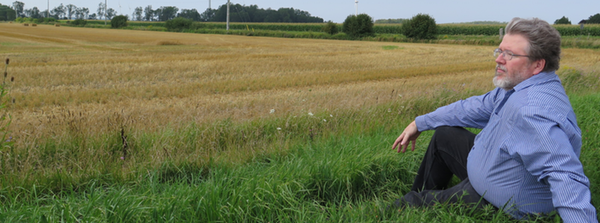
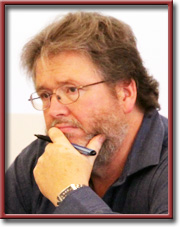
6 Comments
Will
Awesome! And this is only Part One! My only problem: this is an astounding trail leading deep into the heart of an object, an image, a photograph – miraculous in its detail and connections. But here I am now, swallowed up in this all-encompassing world discovered on this journey into history and meaning and psychology; how do I get back out? Can one possibly experience this incredible journey without being forever colored by, becoming part of the twisted connected story binding it all together? I await Part Two…….
William Ramp
Ah, Will, you have already joined me there. There are intimations of that world light and dark, everywhere. Everywhere, there are voices. Welcome, pilgrim.
William Ramp
It’s funny (in an eerie sense) how one can re-read one’s own words days after submitting them only to be struck by a howler one missed entirely and cluelessly. Of the final two images, I wrote: “There’s nothing particularly surreal or of larger social significance about these two images.” No, no, nothing surreal to see here, move along, move along! Just a couple of women with the exact shape of BELLS. Bell, Belle. What gendered and deniably-sexualized clangour did those dresses ring out, so clearly that I, and generations of my ancestors, heard …not a thing?
William Ramp
Here’s a little story to add to the vignette on Don Duncan that is at the centre of this column. The centrepiece of that vignette, in turn, was an iconic cover image of Don on the cover of the February 1966 issue of Ramparts Magazine, under the header, “I Quit!”
At the time I wrote this column, I didn’t identify that image as orphaned or diasporic. It wasn’t an example; it did some work for me and I used it. It’s an image well-remembered by folks of a certain age and political leaning. Ramparts in its heyday was a major force in American journalism.
But not so fast. Ramparts died in 1975. When was the last time you gave it a thought, if ever? The full run is now online, in a relatively out-of-the-way corner of the Web, and it could even be in some journalism history database sold to colleges. But I’d wager 90% of people under 40 have no idea Ramparts ever existed.
It existed largely because of the civil rights movement and the Vietnam War, and it died with the war’s end. The Vietnam conflict itself, despite the Ken Burns documentary, is far less memorable today than either of the World Wars.
And more’s the pity. Because Vietnam was THE template for the shit America got itself into in Afghanistan and Iraq. And will again soon enough. The geopolitical delusions. The bureaucratic stupidity. The pointless, casual brutality mixed with gutfuls of doom and confusion. The crappy or faked intelligence. The anguish. The PTSD.
So, that iconic photo of Don means a lot to a dwindling few. And nothing at all to most today, even most of the the politically-engaged on either right or left.
When I wrote the article, I went looking for a current copyright holder of the contents of Ramparts. It wasn’t easy. The New York Times had run the image in an obit for Don, seven years after his death (oops), credited to Ramparts. In a form-letter response to my query, the organization that handles copyright queries for the NYT told me that copyright now resided with “the copyright holder.” Well, thanks a lot. Whose permission did NYT seek for its vaguely-credited usage? Who knows?
Eventually, I found one claimant to Ramparts content and paid him a small fee to use a photo that appeared to have been taken of a slightly shopworn copy of the physical front cover. He made a point of telling me his rights to that cover did not extend to the photograph of Don that it featured.
I was unable to find out who took Don’s photo for the Ramparts cover before this column ran. I appended to it, in the photo credits, a longish due-diligence disclaimer.
And then it hit me, courtesy of my nephew Kevin Rawlings (himself a gifted writer & photographer), how utterly stupid I’d been.
Although I’m well into my 60’s, I had pursued all my copyright research online, mostly via Inspector Google. I just assumed without even thinking it consciously, that “everything’s online now.” What Kevin did was to send me a link to an online vintage bookseller who had a copy of the Feb 1966 Ramparts issue for sale. The actual physical, material thing. I bit. It arrived a few days ago. Last night, I flipped it open, past that compelling cover image. And there, on the contents page, plain as day, was the photo credit.
I (ahem) Googled the name. The guy was probably dead —the photo had been taken fifty-three years ago after all. But maybe he’d become famous before he became dead.
I came up with a website. Same name, and a photographer, California based. Apparently still active, though up in years.
I dropped him a line on spec. He responded. He Was The Guy.
I wrote back, apologized for having sent my article in before finding him, asked if he would retroactively grant permission for my use of the image, and, if yes, on what terms and for what fee.
He said yes, and added this: “for the past 25 years i am living in the mountains of northeast california and am out of touch with fees and such. i will trust you to be fair.”
From his website bio, it seems his life trajectory somewhat uncannily paralleled Duncan’s. He was at the centre of a major urban-California cultural scene. He spent time wandering. He left the urban scene for places atmospherically far removed from it. From his correspondence with me, he seemed a bit brusque, curt, though not unfriendly —in the manner of some intelligent old men who’ve found their place after a turbulent life, no longer care overmuch what others think of them, and don’t wish to waste their time on niceties. I would so love to interview him, though I quail at asking.
But he’d lobbed a ball into my court on the question of the fee. And I was in a serious financial crunch, having ignored a series of credit warnings during a period of busyness and distraction. I decided to send him a hundred dollars American, using yet another credit card. If I could, I’d quintuple that. As it was, I just couldn’t chintz him out; couldn’t sleep on sending any less than that already paltry amount. It would be another form of forgetting if I did.
That’s the story.
If you’re curious, his name is Erik Weber. And you can find him here: http://www.desart.com
Maura C Hanrahan
How do I subscribe to your blog?
Elizabeth Boleman-Herring
Hi, Maura. Elizabeth-the-Editor here. I’ve sent you an email, but, if it lands in your Spam folder, just know you can email our Asst. Editor, Tim Bayer, at tim@tbayer.com, to be put on our free mailing list. Many, many thanks!!